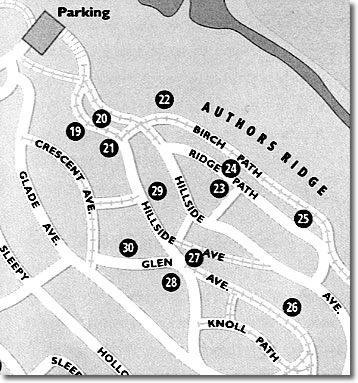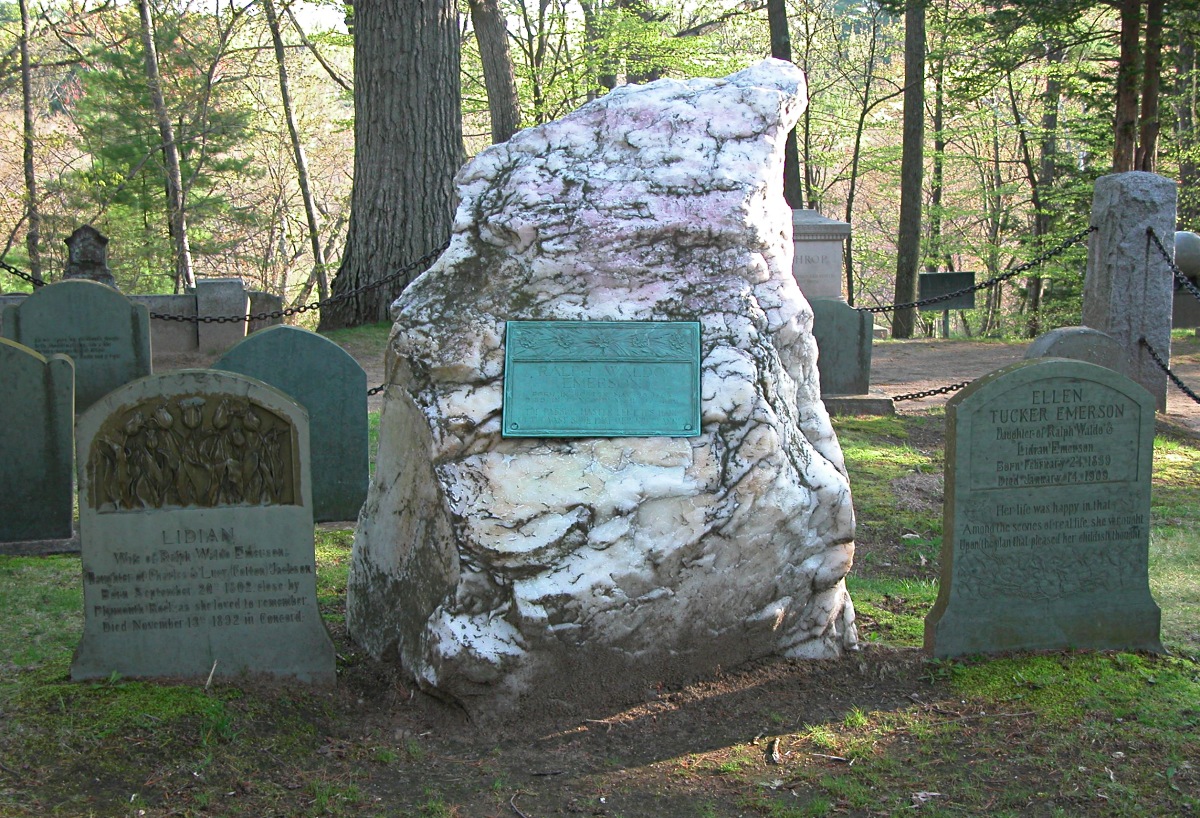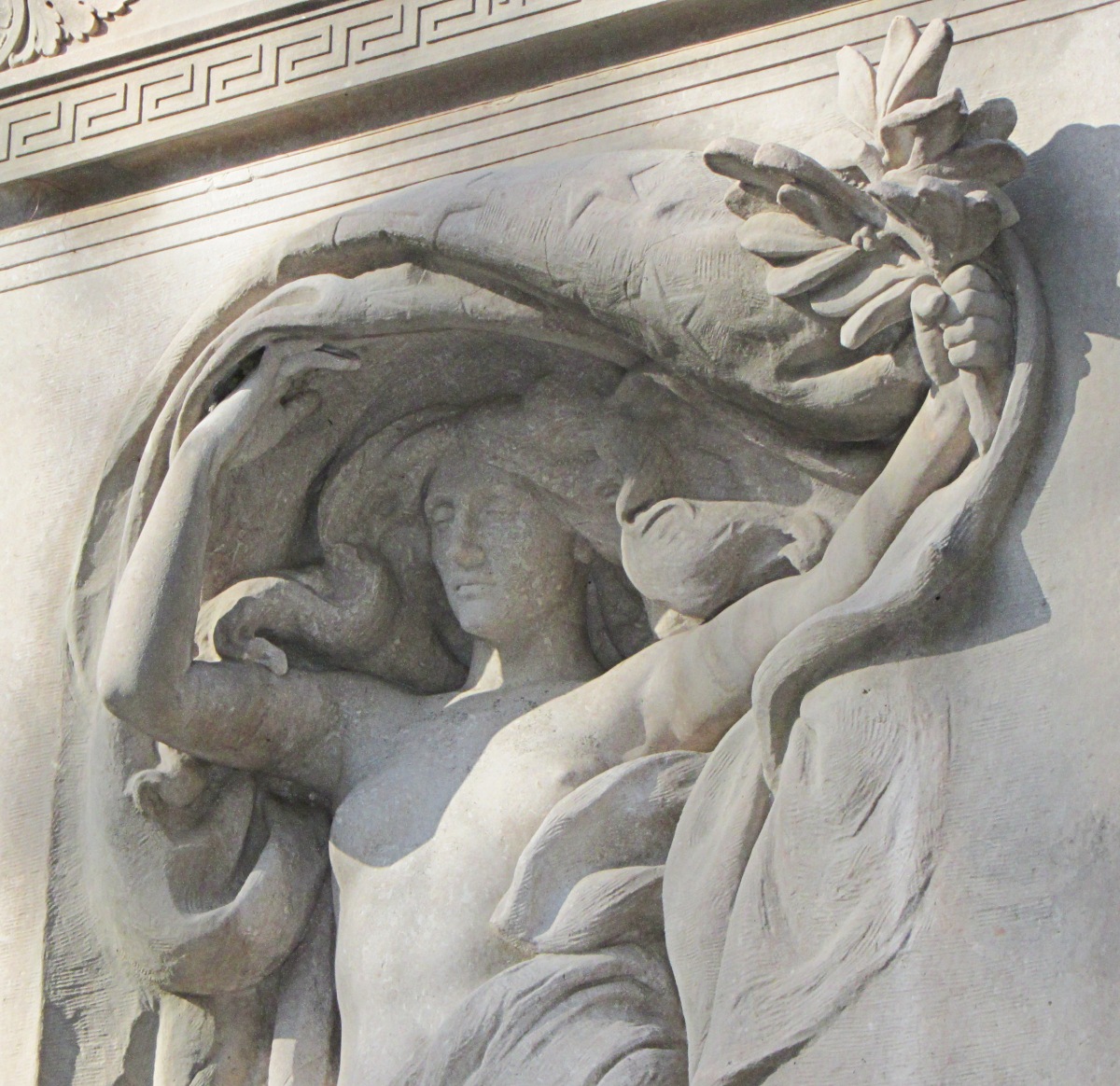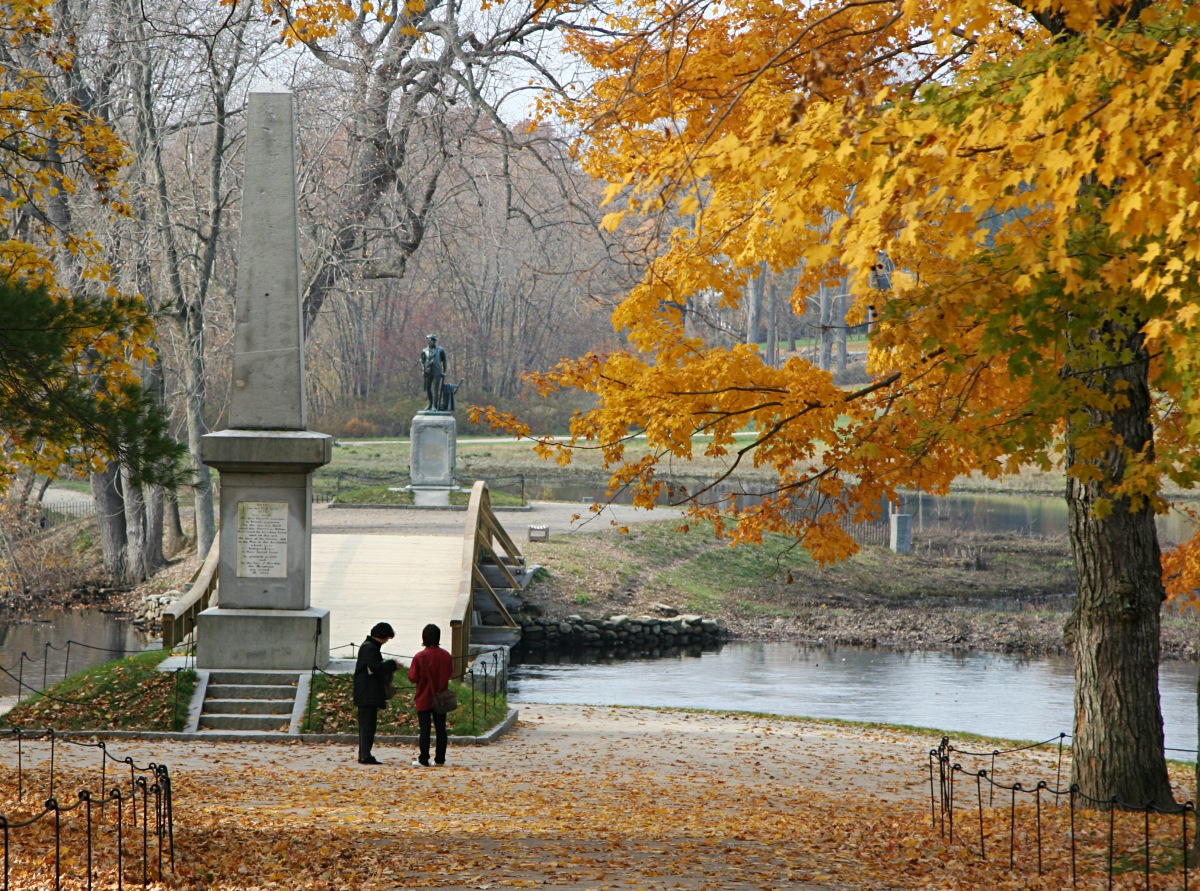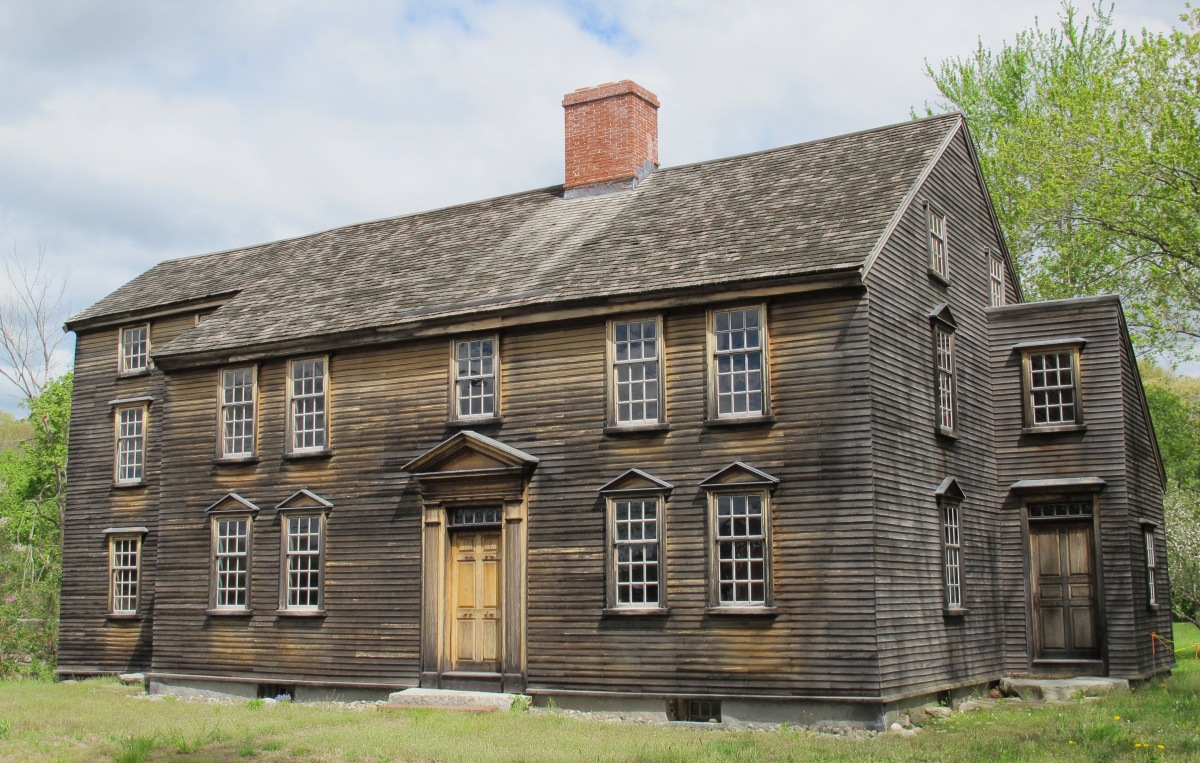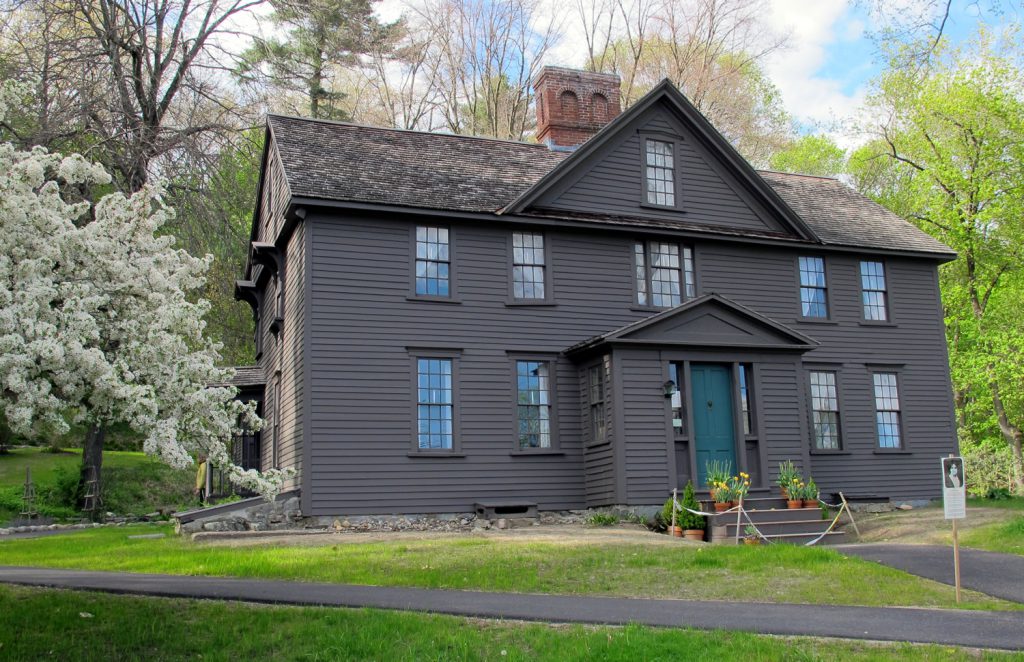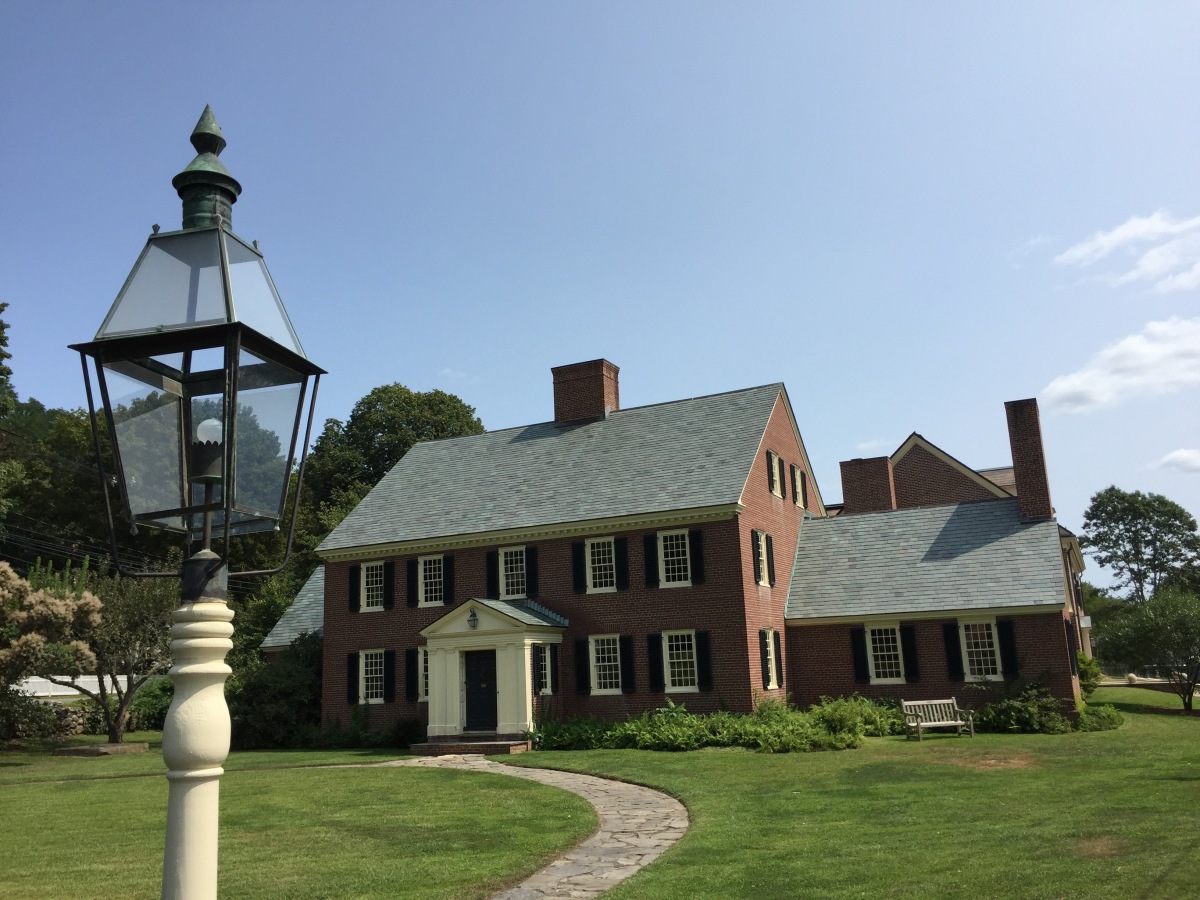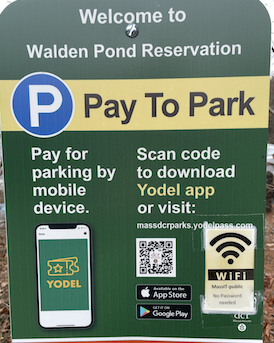Concord, Massachusetts Guide
The pretty town of Concord, 22 miles (35 km) west of Boston Common, is a popular destination for patriotic Americans, and for those wanting to get out of Boston for a day.
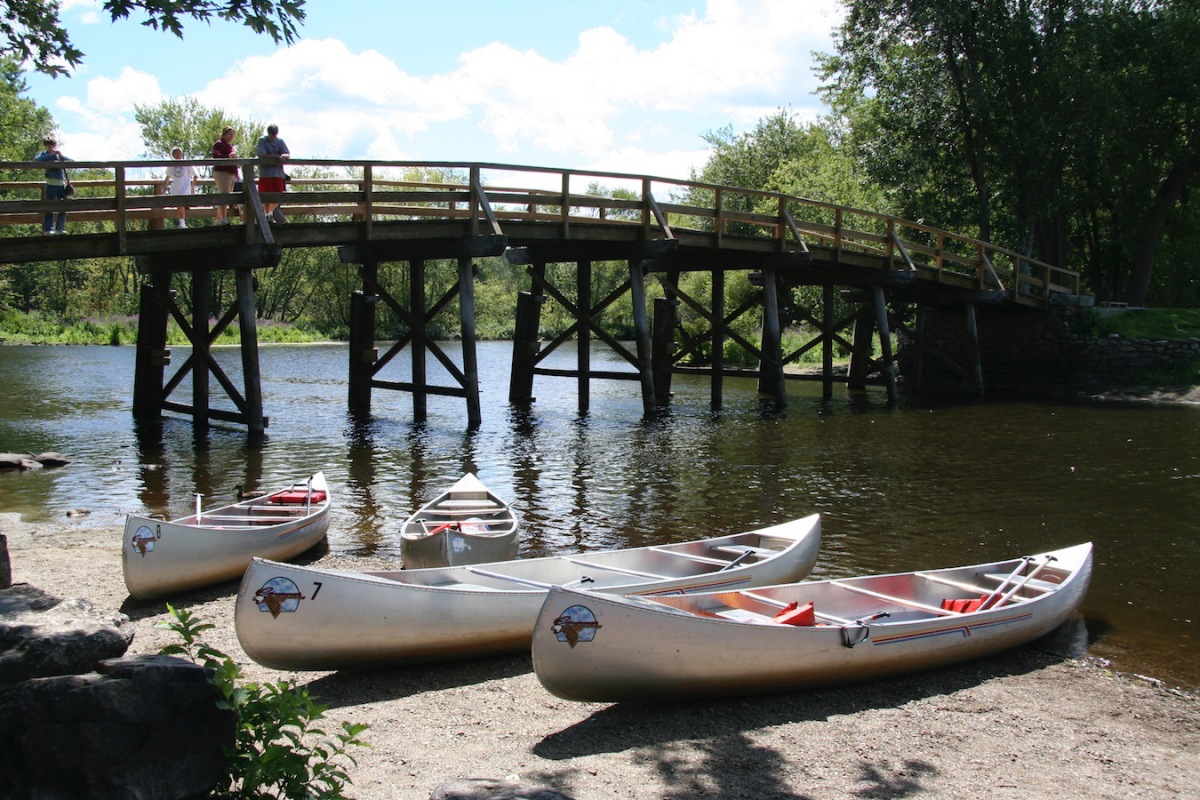
Concord's Old North Bridge, site of the first American military victory (1775) in the Revolutionary War.
Concord, Massachusetts is historic, having been founded in 1635, the oldest European-settled town beyond tidewater in New England.
It was in neighboring Lexington that the first shots of the American Revolutionary War were fired on April 19, 1775, the day now commemorated as Patriots Day in Massachusetts. But the first American victory was at Concord's Old North Bridge, a 7/10-mile (1.1-km, 16-minute) walk north from Monument Square, the town center (map).
You can easily spend a whole day or two in Concord, or you can visit the most important sights in a somewhat rushed morning or afternoon.
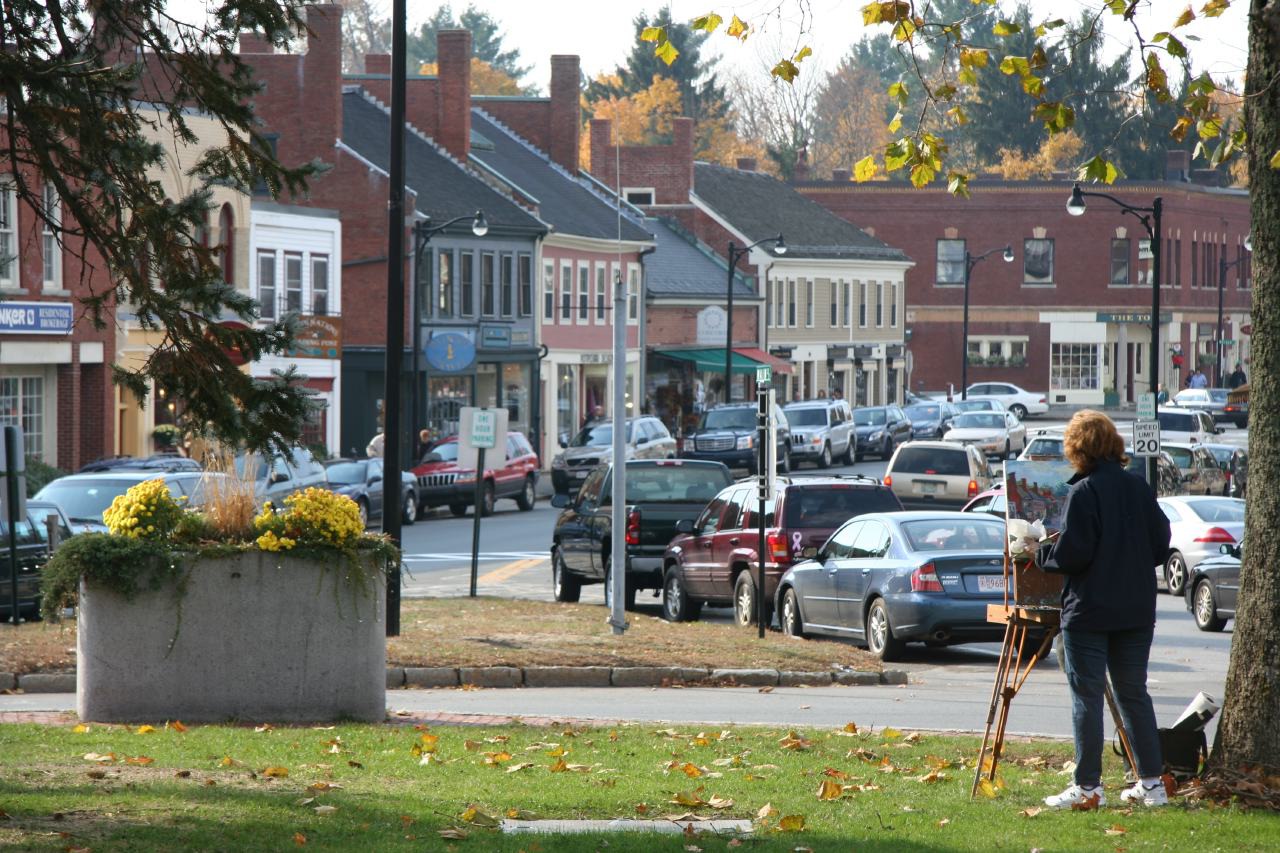
An artist paints Main Street in Concord, Massachusetts...
Concord is a popular excursion destination for visitors in Boston, and even for Bostonians wanting to "get out into the country" for a day of walking, biking, sightseeing, boutique-shopping or even canoeing.
ConcordMA.info
The best source for all this is my Concord-specific website, ConcordMA.info, with its seven Walking Tours taking you to all the important sites.
Concord's many historic sites and buildings provide worthy goals for lots of walks, drives and bike rides. There's also good shopping in Concord center and West Concord, and more than a dozen good places to dine.
Concord Visitor Center
The Concord Visitor Center, off 64 Main Street behind the Middlesex Savings Bank and Bank of America buildings (map) is normally open weekends, mid-April through May, and daily from May through October, from 9 am to 4 pm.
They have brochures, maps, knowledgeable volunteer staff, and clean public toilets. They also organize guided tours of the town.
Behind the Visitor Center is a water fountain and the Concord Town Lot for free parking.
Concord Walking Tour
Here's a 2-hour walking tour of Concord takes you from central Monument Square (map) on a leisurely walk through Concord for 5.2 miles (8.4 km), ending at Monument Square (map).
Monument Square
Concord is unusual among New England towns because it does not have a "town common," or plot of central common pasture land. It has Monument Square, a small rectangular park with its Civil War memorial obelisk, erected in 1866, at the center.
From Monument Square, it's a 10- or 15-minute walk to most of Concord's landmarks, including Sleepy Hollow Cemetery, South Burying Ground, Emerson's House, the Concord Museum, Old North Bridge, the Old Manse, Orchard House, the Wayside, and the Concord Depot (train station).
The Colonial Inn is at the northwest end of the square, the historic Wright Tavern at the southeastern end, the and several historic churches, chief of which is the meetinghouse of the First Parish in Concord (map).
Around the Square
Around Monument Square—actually the "square" is more of a rectangle—are gathered the town's major institutions: the Town House (town hall), First Parish Unitarian-Universalist meetinghouse, Holy Family Roman Catholic church and its rectory, the Christian Science church, and the Colonial Inn.
Concordians love to show visitors that the town lives up to its name in religious matters: Monument Hall, the home of Concord's Knights of Columbus meet right next door to the Masonic Temple, which is right next to the Christian Science church. Everyone gets along in Concord!
Old Hill Burying Ground
Above Monument Square, beside Holy Family church, stands Old Hill, site of the original hamlet of Concord, now covered by the Old Hill Burying Ground, also called the North Burying Ground, one of Concord's two colonial-era cemeteries. More...
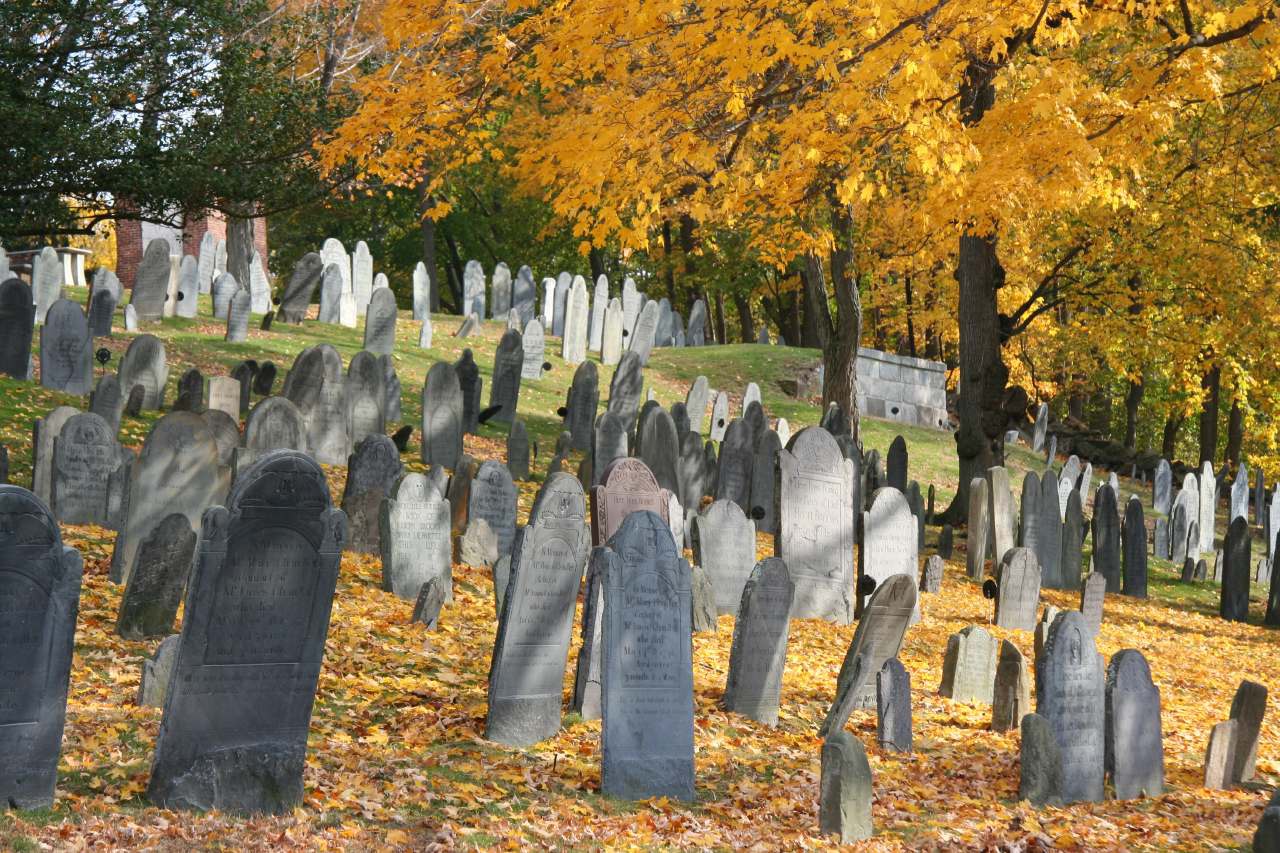
Old Hill (North) Burying
Ground, just off Monument Square.
Sleepy Hollow Cemetery
A 10- to 15-minute walk northeast brings you to Authors Ridge in Sleepy Hollow Cemetery, with the graves of many famous Concordians.
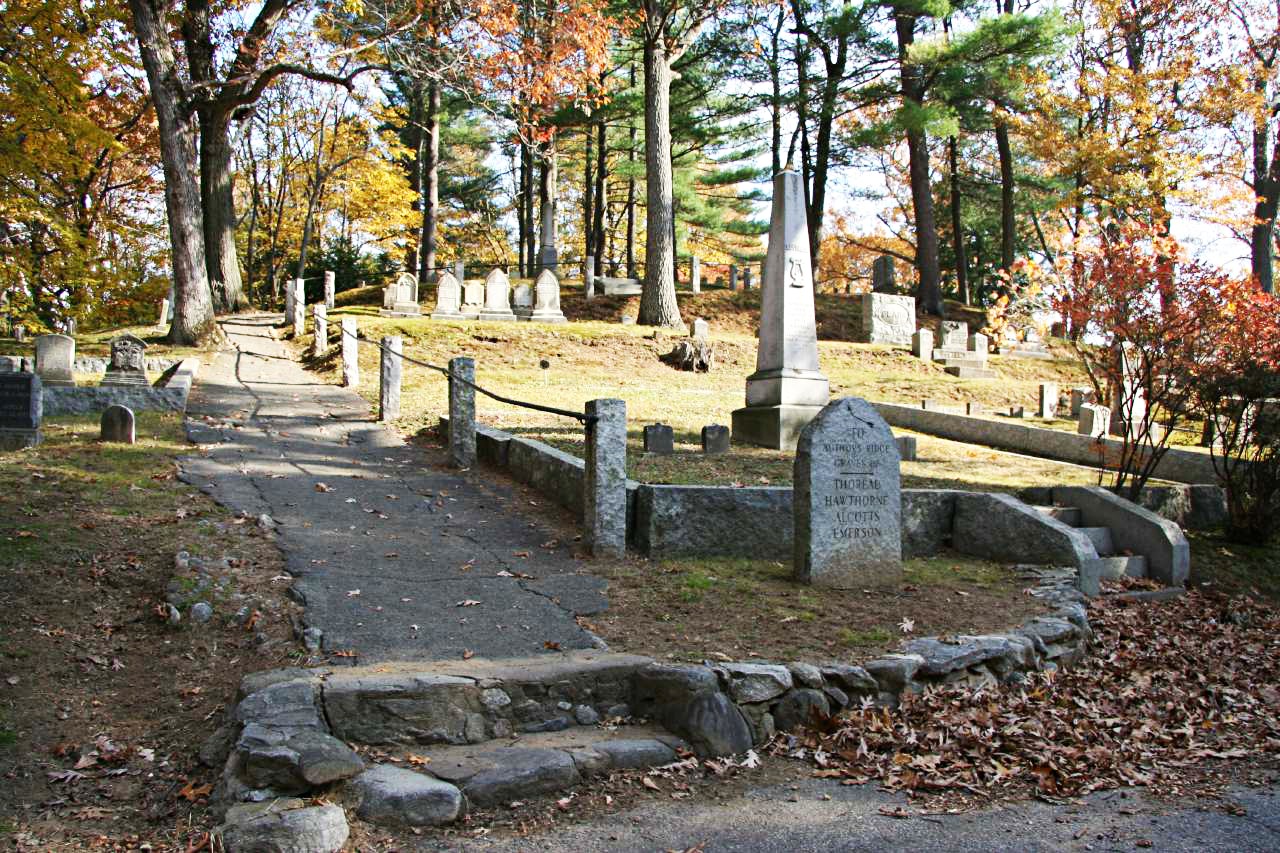
Authors Ridge in Sleepy Hollow Cemetery, resting-place of Louisa May Alcott, Nathaniel Hawthorne, Ralph Waldo Emerson, Henry David Thoreau and their families.
The Garden Cemetery
Designed as an early American example of the garden cemetery, Concord's Sleepy Hollow Cemetery was inspired by Ralph Waldo Emerson's philosophies as well as Sir Christopher Wren's earlier idea of designing landscaped burial grounds located outside of churchyards and city centers.
In fact, it was Emerson who gave the speech at the dedication of Sleepy Hollow Cemetery in 1855.
Paris's Père Lachaise Cemetery, opened in 1804, was the first full example of Wren's ideas, and is still a model for the best. The first garden cemetery in the USA, and one of the finest, was Mount Auburn Cemetery in Cambridge MA.
Getting There
The cemetery is only a few minutes' walk northeast from Monument Square (follow "Route 62" signs; map), but it's a 13-minute walk from the square to Authors Ridge, which rises at Sleepy Hollow Cemetery's northeast edge.
If you're following my Concord Walking Tour, on your way back from the Old Manse and Old North Bridge, along Monument Street, turn left on Court Lane before you reach Monument Square, to get to Sleepy Hollow Cemetery.
The Friends of Sleepy Hollow Cemetery (PO Box 1245, Concord MA 01742) have published a map of the cemetery for sale at several locations in Concord which are listed on their website. More...
Authors Ridge
Authors Ridge in Concord's Sleepy Hollow Cemetery, less than a 15-minute walk northeast of Monument Square (map), is a place of pilgrimage for many Americans.
Young girls enthralled by Louisa May Alcott's Little Womenco me to visit her grave. Independent thinkers indebted to Ralph Waldo Emerson's life and work pay their respects at the rough marble boulder that is his tombstone. Naturalists and conservationists leave votive offerings at the headstone of Henry David Thoreau, America's first great ecologist.
How to Get There
Authors Ridge is less than 15 minutes' walk from Concord's Monument Square (map). From the square, go to the left of Holy Family Roman Catholic church on MA Route 62 (Bedford Road) toward Bedford. After one block you'll come to the pedestrian entrance to Sleepy Hollow Cemetery, and if you're walking or biking you can enter the gate here, turn right and follow the lane northeast.
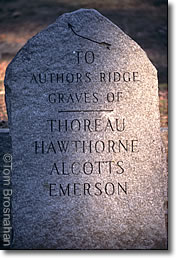 |
|---|
If you're driving, don't enter the Pedestrian Gate.on Court Lane. Bear right onto Bedford Street (MA Route 62) and drive a short distance to the next gate, Prichard Gate, designated for auto entry. Turn left and enter here, bear right at the Y, then immediately left on a one-way lane; a stone marker points the way to Authors Ridge. Follow the curve of the lane to a small parking area, then walk up the paved path to the ridge. Click here for how to get a full map and guide to Sleepy Hollow Cemetery from the Friends of Sleepy Hollow.
Map of Authors Ridge
19. Henry
David Thoreau & Family
20. Nathaniel, Sophia
& Una Hawthorne
21. Louisa May Alcott
& Family
23. Ralph
Waldo Emerson & Family
24. Harriet M Lothrop ("Margaret Sidney")
Authors' Graves
Walk up the hill as indicated by the stone waymarker. Here are the authors' graves, in the order you pass them:
Thoreaus
Henry David Thoreau no doubt knew this ridge well. He knew all the land in Concord from his daily walks as recounted in his journals and books, including Walden.

Pencils, pens, coins, notes & messages, stones, pine cones & oranges for Henry.
His simple headstone in the Thoreau family plot is always surrounded by votive offerings left by readers of his works who come from around the world to pay homage to America's first great naturalist.
Among the offerings it's common to find pencils, because Thoreau and his father John Thoreau ran a company that developed and manufactured the best pencils in the USA at the time. Pencils supported Thoreau in his studies at Harvard, during his life, and in his literary efforts.
Hawthornes
Nathaniel Hawthorne (1804-1864) was born in Salem MA, as was his future wife Sophia Amalia Peabody [Hawthorne] (1809-1871). They lived only one street apart as children.
After their marriage in 1842, Nathaniel and Sophia moved into Concord's Old Manse. They later lived for years at The Wayside, near Orchard House on Lexington Road in Concord.
Nathaniel died (perhaps of stomach cancer) in 1864 while on an outing in New Hampshire's White Mountains with former US President Franklin Pierce, a Bowdoin classmate.
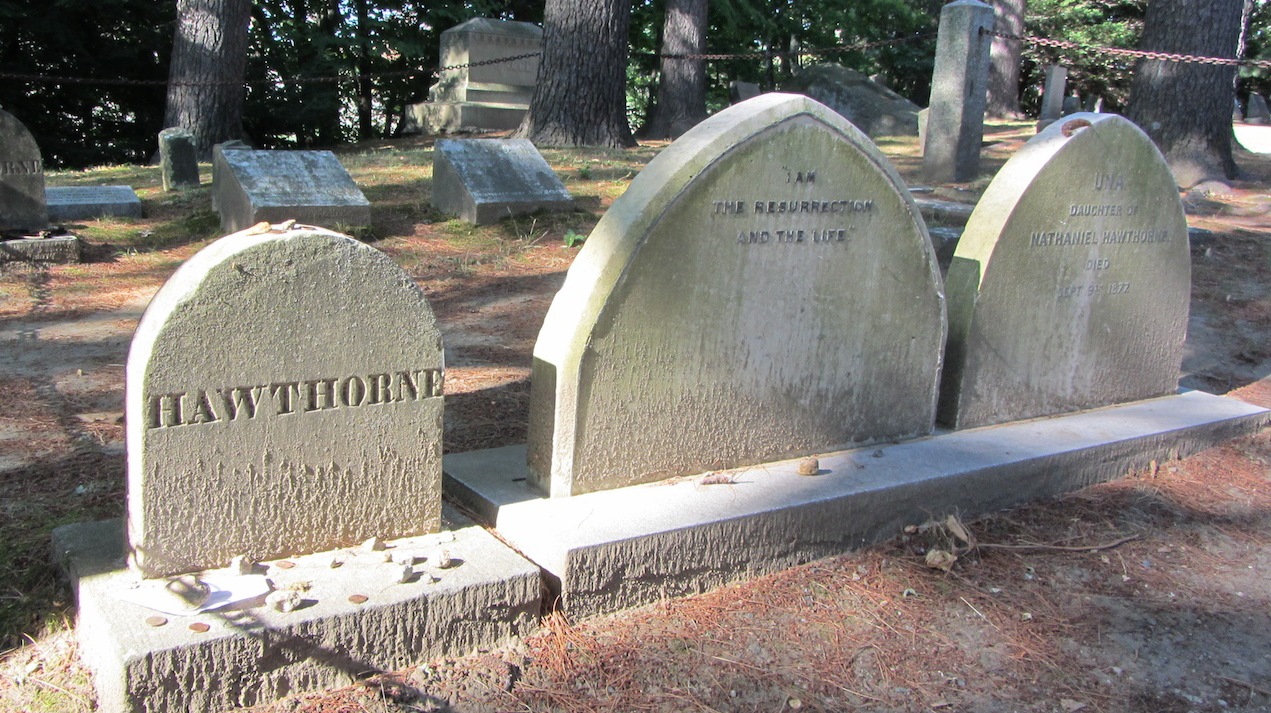
Graves of Nathaniel, Sophia & Una Hawthorne...
His wife Sophia and daughter Una moved to England after Nathaniel's death, and were buried there (1870s) in Kensal Green Cemetery. In June 2006 their remains were brought to Concord and re-interred here in the Hawthorne family plot.
Hawthorne was painfully shy. He probably receives more visitors in death here on Authors Ridge than he had during his lifetime.
Alcotts
Louisa May Alcott's grave in Sleepy Hollow Cemetery is a place of pilgrimage for thousands of girls captivated by her novel Little Women. Her father Amos Bronson Alcott, her mother Abigail May Alcott and her sisters are buried in the Alcott plot just past the Thoreau family plot.
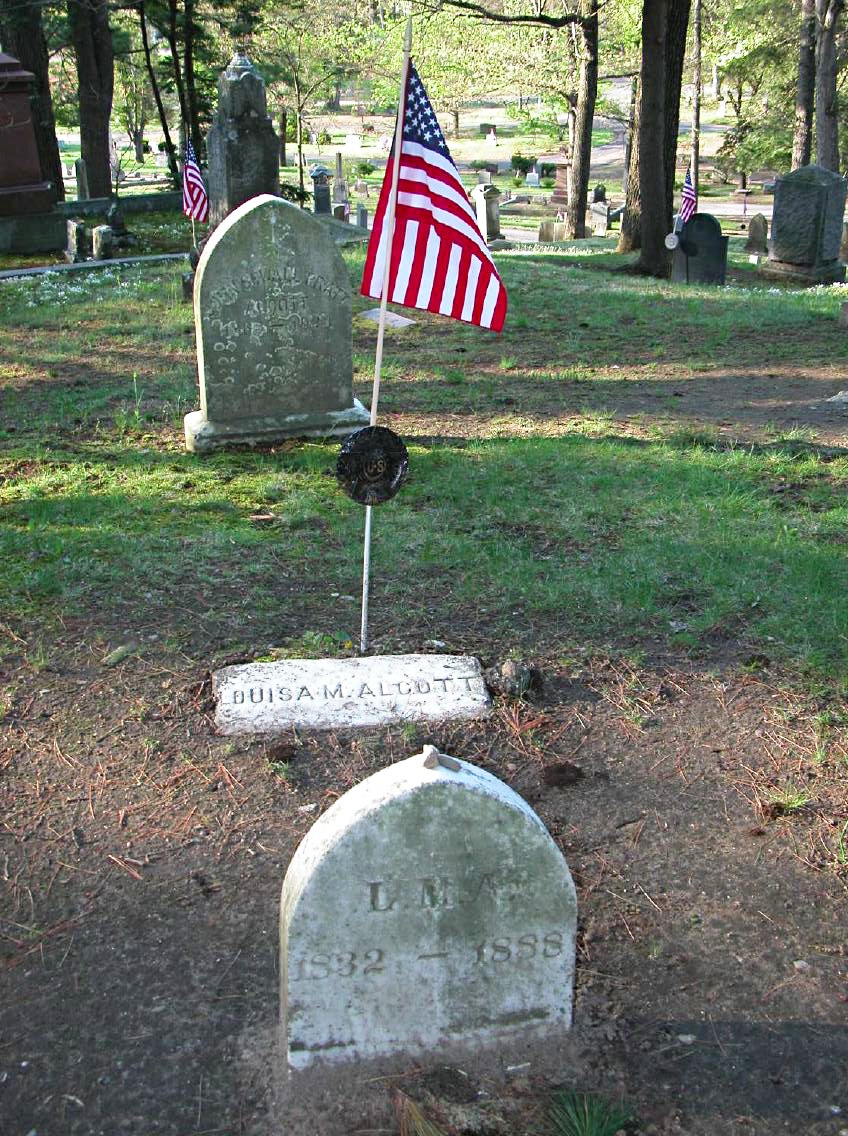
Louis May Alcott is honored with an American flag on her grave for her service as a nurse during the American Civil War (described in her Hospital Sketches).
She died of a stroke on March 6, 1888, aged 55, two days after the death of her father, Bronson Alcott.
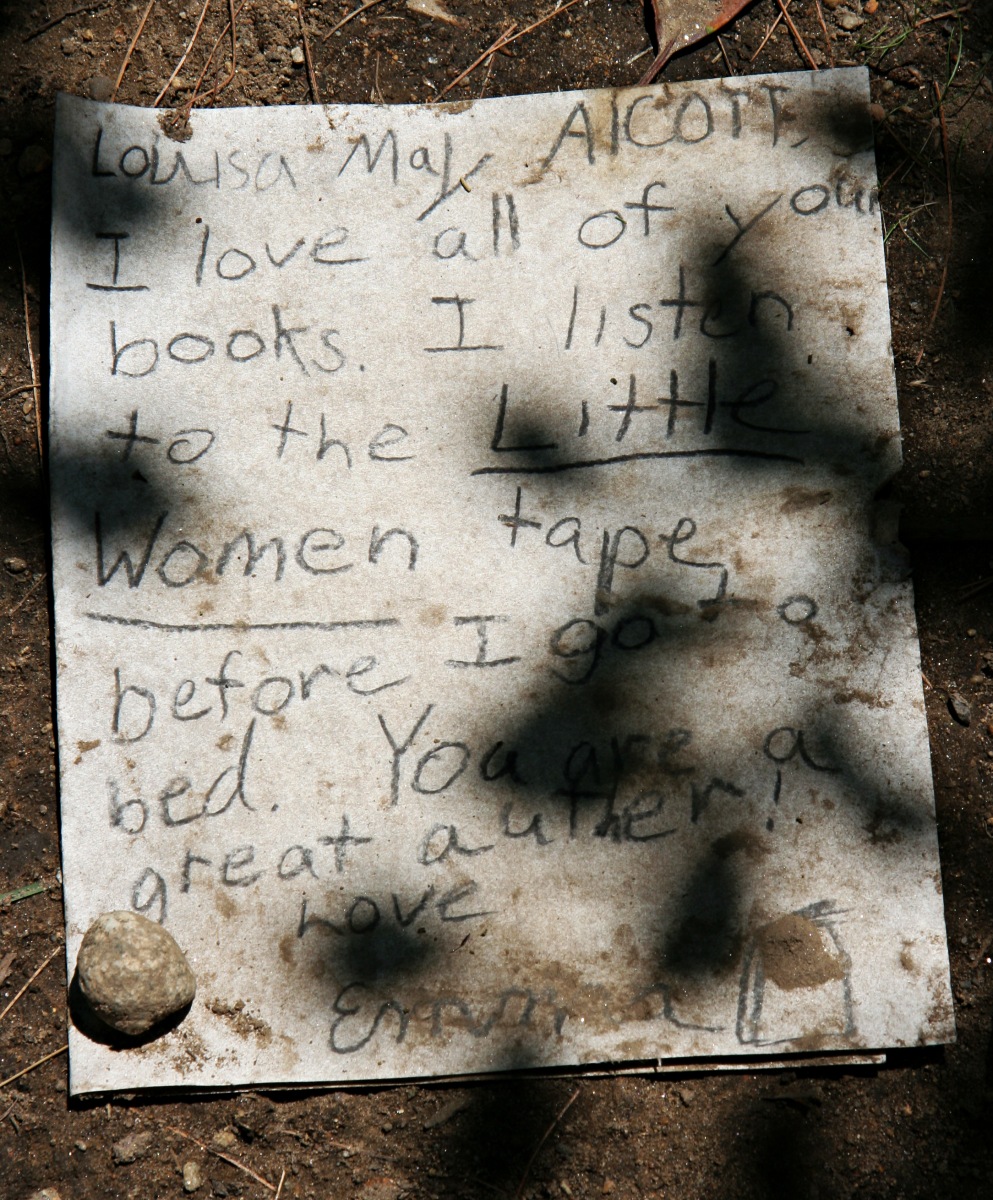
Emersons
Emerson gave a speech at the dedication of Sleepy Hollow Cemetery (1855), with the thought in mind that he would one day lie here. Now he does, his grave marked by a large, rough boulder of New England rose quartz—a non-religious symbol for a man who started his career as a Christian minister.
Shaded by oaks and evergreens, enclosed by chains supported by granite posts, the foremost gravestones are those of Ralph Waldo Emerson (1803-1882; center), Lidian Jackson Emerson (1802-1892; his wife, left) and Ellen Tucker Emerson (1839-1909; their daughter, right).
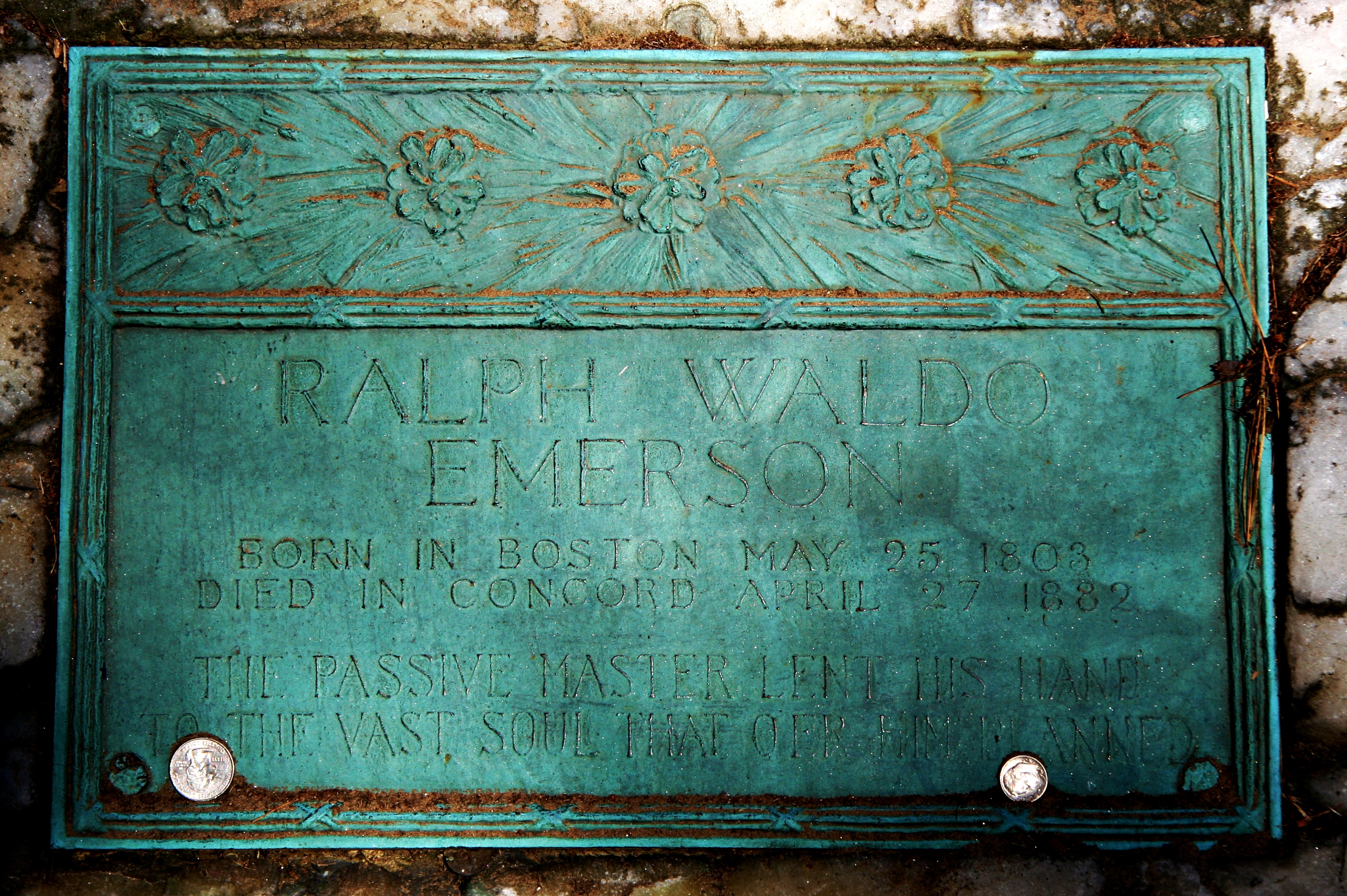
RALPH WALDO EMERSON
BORN IN BOSTON MAY 25 1803
DIED IN CONCORD APRIL 27 1882
THE PASSIVE MASTER LENT
HIS HAND
TO THE VAST SOUL THAT OER HIM PLANNED
A particularly touching monument is that of the Emersons' son Waldo, whose death at age 5 broke the hearts of his parents.
French
You may also want to visit the grave of Daniel Chester French on the ridge you curved along on your way to Authors Ridge. French was the sculptor of The Minuteman, the statue at Concord's Old North Bridge; the Seated Lincoln (in the Lincoln Memorial, Washington DC); and the Melvin Memorial, not far from his grave on the other side of the ridge (see below).
It's ironic that the great sculptor has such a simple tomb when in life he created such memorable memorials to others:
- The Mourning Victory of the Melvin Memorial in Sleepy Hollow
- The marble statue of Ralph Waldo Emerson in the Concord Free Public Library
- The Minute Man at Concord's North Bridge
- The "Seated Lincoln" in the Lincoln Memorial, Washington DC.
Visitors sometimes leave pennies on his tombstone with the reverse side up, showing the image of the Lincoln Memorial.
For a look at Daniel Chester French's life, visit his home and studio at Chesterwood at Stockbridge in Massachusetts's Berkshire Hills.
Ephraim Wales Bull
Down the hill from the Emerson plot is the grave of Ephraim Wales Bull, inventor of the Concord grape, from which the Welch's company made a fortune in grape jelly and juice. Bull, who died without profiting greatly from his useful agricultural development, has a tombstone inscribed He sowed, others reaped.
Melvin Memorial
Daniel Chester French's memorial in honor of three brothers of Concord's Melvin family who died in the Civil War is at the bottom of the south side of the ridge.
Four brothers of the Melvin family went off to the Civil War. Only one returned, James C Melvin, who prospered in civilian life. In 1897 he commissioned sculptor Daniel Chester French to create a monument at the center of the planned memorial for his three lost brothers.
French, who later created the colossal statue of Lincoln for the Lincoln Memorial in Washington, sculpted the Mourning Victory, among the most eloquent of his works, in 1906-1908. He adhered to the prevailing Art Nouveau style, perfectly suited to portray the nobility of the brothers' sentiments, the tragedy of their sacrifice, and the bittersweet poignancy of victory in the cause for which they gave their lives.
The memorial was dedicated in 1909. The inscription reads:
In memory of three brothers born in Concord
who as private soldiers gave their
lives in the war to save the country.
This memorial is placed here by their surviving
brother, himself a private soldier in the same war.
'I with uncovered head
salute the sacred dead
who went and who return not.
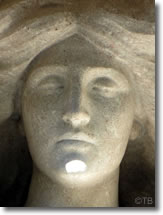 |
|---|
The figure of Victory emerges from the stone, a look on her face of profound sadness and the numbness of long grief. In her hand is an oak branch to award to the victors—but they are gone.
The Melvin Memorial is at an intersection of three lanes within Sleepy Hollow Cemetery (map), only a short distance from the main auto gate.
French's original design was for a mirror image of what you see here today: the oak branch in Victory's right hand, and her left holding up the American flag (as shown in this copy made by French four years later for New York's Metropolitan Museum of Art.) However, the placement of the monument would have had Victory's elbow obscuring her face as visitors approached, so French "flipped" his original design to suit the site.
Having deteriorated over the 110 years since its dedication, the memorial was carefully restored in 2018, and re-dedicated on June 16, 2019.
In winter, the Mourning Victory is shrouded by a heavy waterproof cover to protect it from deterioration by the elements, and is thus not visible. Visit in the warm months.
Daniel Chester French's grave is on the ridge directly behind the Melvin memorial.
Minute Man National Historical Park
The first battles of the American Revolutionary War were fought in Lexington and Concord, Massachusetts. Minute Man National Historic Park preserves many places and sights important to this essential period of American history. NPS offers a smartphone app to guide you through the park.
Battle Road, the route followed by British expeditionary troops as they marched out from Boston in search of illegal military supplies, is the park's "spine," snaking from Lexington Green to Concord's Old North Bridge (map).
Visitor Centers
There are two Visitors Centers, the North Bridge Visitor Center up the hill from the Old North Bridge in the Buttrick Mansion, and the Minute Man Visitor Center near the eastern end of the Battle Road Trail off MA Route 2A just west of Interstate 95/MA 128 (map).
A large parking lot near North Bridge is often full during the summer, and if you have a good parking spot in town, and a few extra minutes, walk the 7/10 mile (1.1 km, 15 minutes) to the bridge and admire Concord's lovely old houses along Monument Street as you go.
The Concord Fight
At dawn on the morning of April 19th, 1775, the Lexington Minutemen, far outnumbered, exchanged shots with British regulars on Lexington Green. Minutemen fell wounded and dead.
After the batle, the British officers headed their men quickly off to Concord, afraid—no, certain—that since shots had been fired and men killed, there'd be a great deal more trouble coming.
Of course, the Minutemen in Concord knew of the Lexington fight shortly after it happened and long before the British troops arrived in Concord at 7 am.
The local Minutemen kept an eye on the British as they entered Concord, waiting for whatever was to happen. A force of about 90 regulars was sent across the North Bridge toward Colonel Barrett's farm, where spies reported that guns and ammunition were hidden. Another 90 remained at the bridge to guard it. The Minutemen retreated before the regulars, crossing the bridge and taking up a position on Punkatasset Hill, in sight of the bridge, where they awaited reinforcements from Acton, Bedford and Lincoln.
Meanwhile, in the Concord town center, the British force carried out a polite and not-too-thorough search. Some arms were found, in particular a number of gun carriages, which were brought out and burned. By this time, the Minuteman forces on Punkatasset Hill had grown to number about 400. They saw the smoke, assumed the British were torching their town, and began to advance in revenge.
The British regulars retreated across the bridge and began firing at the Minutemen, who fired back and pursued them as they retreated. It was here at the North Bridge, then, that the Minutemen fired "the shot heard 'round the world," a militia of simple farmers attacking the finest professional soldiers in the world.
Soon afterward ,the British troops began their march back to Boston, but Minutemen kept up a constant sniper fire on them all the way, which enraged the regulars and goaded them to murder some of the innocent persons they met along their route.
The bitterness left on both sides by the events of April 19, 1775, would soon bring war to all the British colonies in North America.
Old North Bridge
Every visitor to Concord makes the patriotic pilgrimage to the Old North Bridge, walking from the parking lot down the tree-shaded earthen road to the small obelisk at the near end of the bridge, the 1836 Battle Monument,
HERE On the 19 of April, 1775, was made the first forcible resistance to British aggression. On the opposite Bank stood the American Militia. Here stood the Invading Army and on this spot the first of the Enemy fell in the War of that Revolution which gave Independence to these United States. In gratitude to GOD and In the love of Freedom this Monument was erected AD. 1836.
Look to the left to see a plaque on the stone wall commemorating two British soldiers who died in the battle and were buried here.
Walk across the placid Concord River on the bridge, modern reproduction of the kind of bridge that spanned the river in colonial times). It's easy to imagine, almost to see, the way things happened on the day of the battle.
At the far side is Daniel Chester French's first important statue: The Minute Man. (French later (1920) sculpted the "Seated Lincoln" for the Lincoln Memorial in Washington, DC.)
On the statue's plinth is the first stanza of Emerson's famous Concord Hymn:
By the rude bridge that arched the flood,
Their flag to April’s breeze unfurled,
Here once the embattled farmers stood
And fired the shot heard round the world.
Beyond the statue, follow the gravel path uphill through the meadow to the Buttrick Mansion, now a National Park Visitor Center and shop.
The Old Manse
A short distance from Old North Bridge, at 269 Monument Street (map), is the Old Manse, historic home to the Emerson clan and, for a short time, to newlywed author Nathaniel Hawthorne and his bride, Sophia.
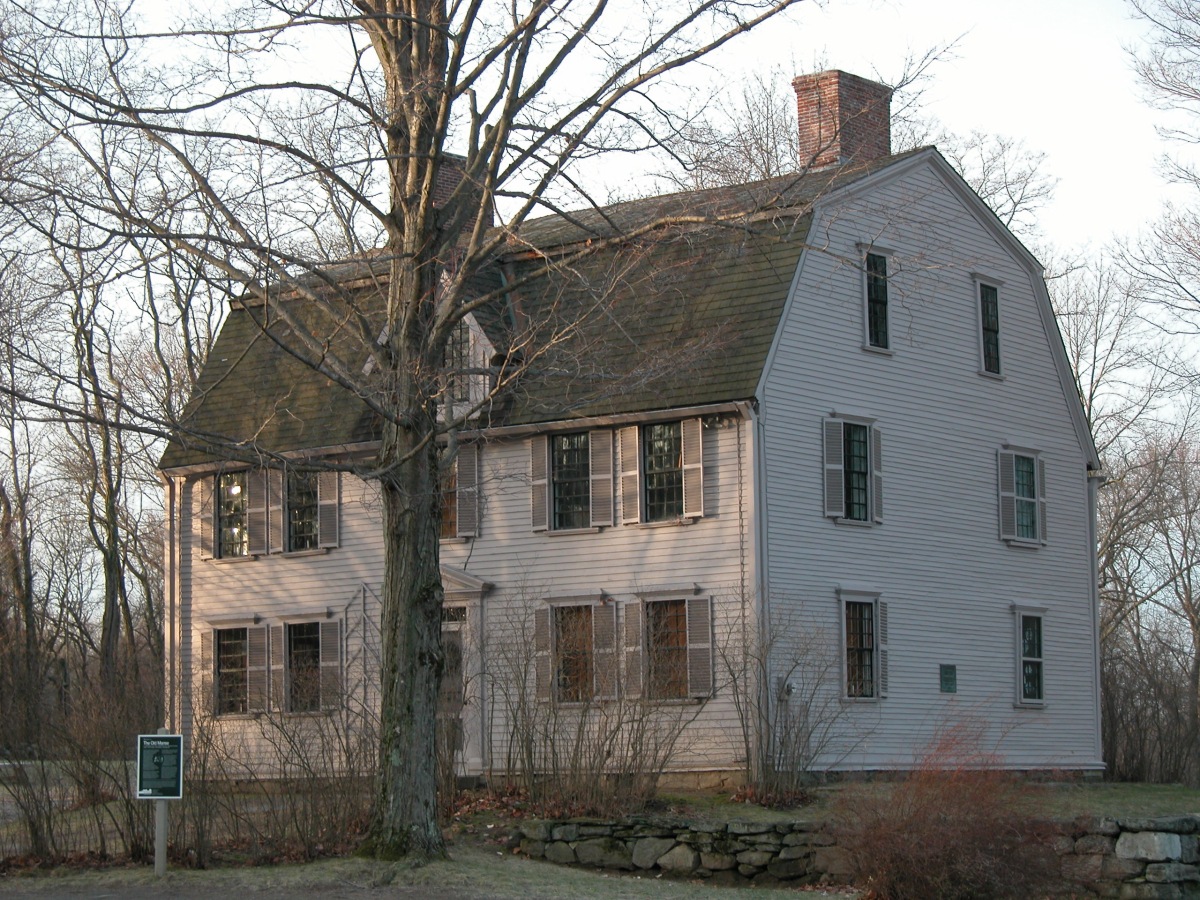
The Old Manse, home to Emersons and Hawthornes.
Built in 1770 by Rev. William Emerson Sr. (1743-1776), the house was relatively new when, on the morning of April 19, 1775, British redcoats marched past it and across the North Bridge on their way to Colonel Barrett's farm to search for hidden arms and ammunition.
Reverend Emerson's grandson, Ralph Waldo Emerson (1803-1882), knew the Old Manse well as a child visiting his widowed grandmother, Phebe Bliss Emerson, and her second husband, Rev. Ezra Ripley (1751-1841).
Nathaniel and Sophia Hawthorne rented and moved into the Manse just after their wedding in 1842, staying until 1845. Hawthorne's residence here gave the shy, reclusive writer material for several later stories collected in Mosses from an Old Manse.
Now cared for by The Trustees of Reservations, the house today is filled with the spirit and the mementoes of the Emerson clan, and of Nathaniel and Sophia's short stay. Your guide will proudly point out where Sophia scratched her name into a windowpane with her diamond wedding ring.
In front of the house, a heritage garden is planted each spring with flowers and vegetables as the Emersons and Hawthornes might have known them: hugely tall corn stalks, big pumpkins and more.
Colonel James Barrett's Farm
About two miles to the west along Barrett's Mill Road (map) is the goal of the British redcoats on that fateful day: the Colonel James Barrett House, 448 Barrett's Mill Road, Concord MA (map). The house is only open to the public on special occasions (especially on Patriots Day, April 19th), though you can always view it from the outside.
From Concord's Monument Square, follow Lowell Road (to the left of the Colonial Inn) to north to the blinking light and turn left onto Barrett's Mill Road (map). The Barrett Farm is a mile along on the right-hand (north) side, just past Strawberry Hill Road.
A Bit of History
British spies had good information: illegal arms, gunpowder and other military matériel were indeed hidden at Colonel Barrett's farm.
In fact Barrett, colonel of the Middlesex Minutemen, had directed the stashing of 10 tons of musket balls and cartridges, four small brass cannons, 50 reams of cartridge paper, 31 barrels of flour, 17-1/2 tons of rice, and 8-1/2 tons of dried fish to thirty houses throughout the towns of Middlesex County, with significant quantities—including the brass cannons—stored at his own farm.
When the redcoats crossed the North Bridge over the Concord River on April 19, 1775, they were turned back by musket fire from 400 Minutemen under the command of Colonel Barrett himself in the first American victory of the Revolutionary War (now celebrated each April on Patriots Day).
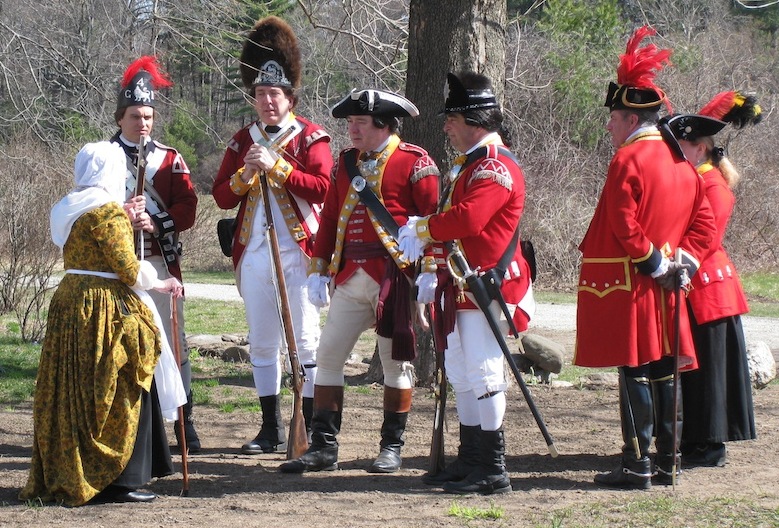
Redcoats question Mrs. Barrett about hidden munitions during a re-enactment on Patriots Day.
Three Centuries, Two Owners
Colonel Barrett had received a land grant for his farm from the king of England. In 1910, the Barrett family sold the farm to the McGrath family, and thus the farm changed owners only once in more than three centuries.
The original farmhouse (1705), inhabited right through the 20th century, had fallen into woeful disrepair. Neglect had its good side: the house saw very few modifications or modernizations over the centuries. A surprising amount of the structure remained just as it had originally been built.
Acquired by Save Our Heritage, Inc. under an agreement with the National Park Service, the Barrett house was carefully restored in 2011. All of the work was done using traditional hand tools: axes, adzes, augurs, chisels and knives—no chain saws, power drills or routers.
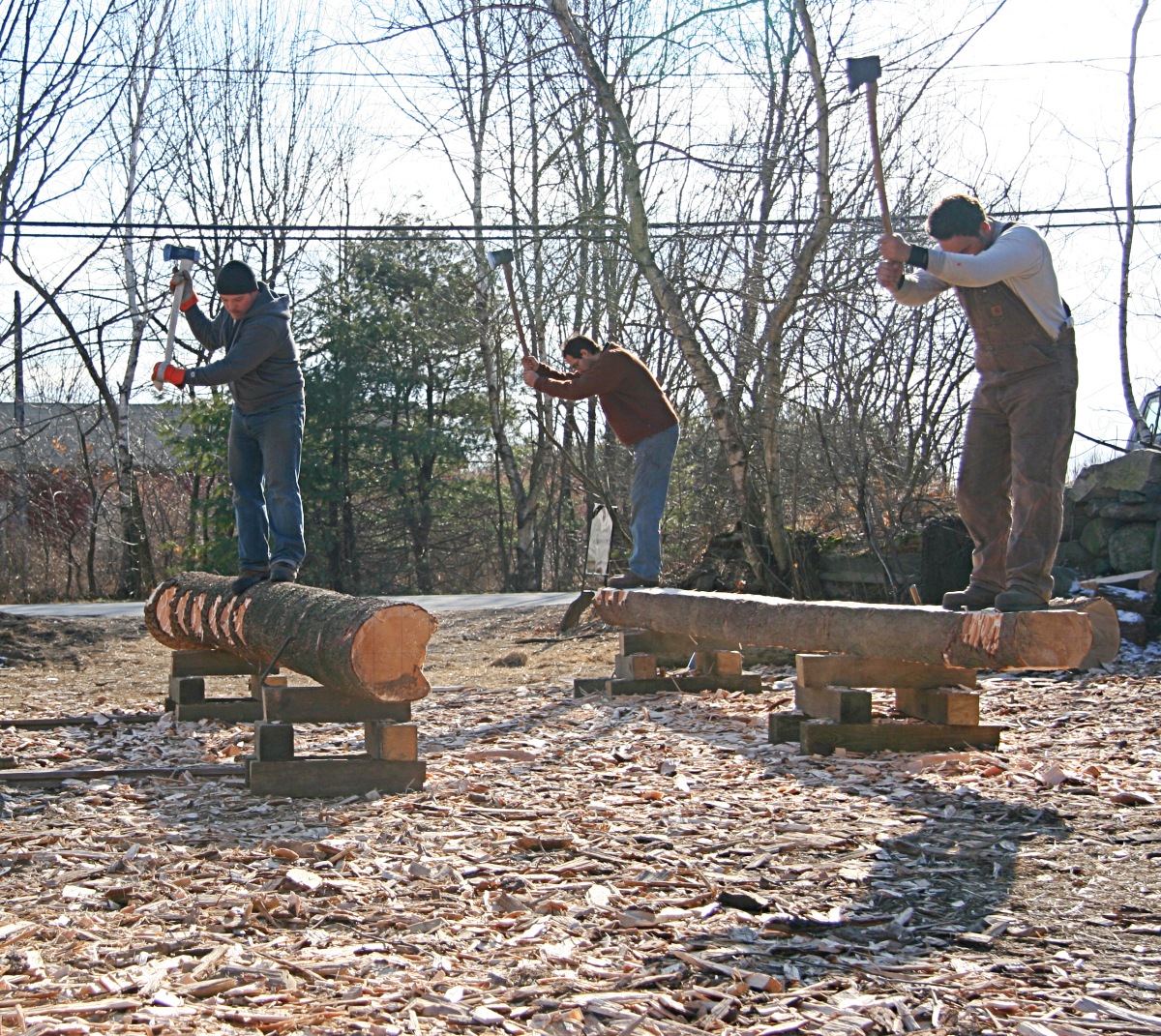
Joseph Roy, Chad Mathrani & Daniel Pedersen at work on white oak logs.
Caesar Robbins House
At the far edge of the Old North Bridge parking lot is the restored Caesar Robbins House, now Concord's African-American and Abolitionist History Center.
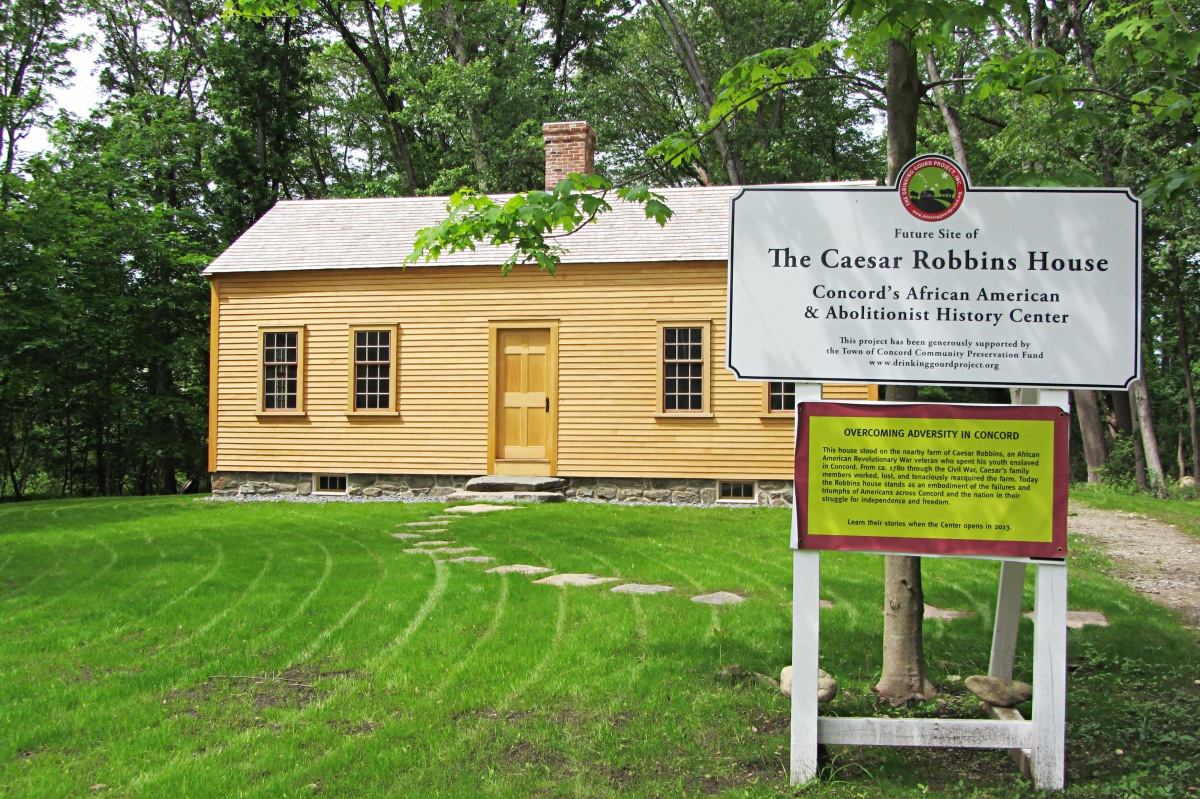
Caesar Robbins House near the North Bridge, Minute Man National Historical Park.
Concord has had inhabitants of African descent since the 1600s. Most were or had lived enslaved (in this cradle of liberty!) Some gained their freedom, though they were still subject to racial discrimination.
In the mid-1800s, Concord was an important way-station on the Underground Railroad, that system of helpers and safe houses by which the enslaved could travel from slave states—and free states in which it was illegal to help an "escaped slave"—to freedom in Canada, where slavery was forbidden.
Some prominent Concordians were early advocates for the abolition of slavery. These Abolitionists were often subjected to defamation and ridicule, but courageously continued their work. Ralph Waldo Emerson did not concern himself with the topic of slavery at first, but later became an ardent Abolitionist and supporter of the cause.
Henry David Thoreau, the naturalist and chronicler of life in Concord, mentioned several African-American Concordians in his work. Brister's Hill and Brister's Spring, between Concord Center and Walden Pond, are named for Brister Freeman, a slavery survivor who lived and farmed here for many years.
The Alcotts' Orchard House
A mile (1.6 km) east along Lexington Road from Concord's Monument Square (a 15- to 20-minute walk; map) brings you to Orchard House, 399 Lexington Road, home of the Alcotts from 1858 to 1877. Author Louisa May Alcott (1832-1888) lived here in 1868 and wrote Little Women, her autobiographical best-seller.
Bronson Alcott started life as an itinerant gizmo salesman, but his life's passion was the reform of traditional education methods. He founded the Temple School in Boston that treated children as fully intelligent beings worthy of respect and affection rather than as discipline problems.
His open and natural approach to education was not appreciated there, but it was perfectly congenial in Transcendentalist Concord. He was commissioned Concord's superintendent of schools, and he opened a "School of Philosophy" in a building in his backyard.
Orchard House is a must-see for anyone, especially a child, who has read Louisa May Alcott's Little Women, or seen one of the movies based on the book. It's a thrill to see the real rooms and artifacts of the author's life, and to be in the milieu in which she grew up.
Just east of Orchard House is The Wayside (see below), where the Alcotts lived from from 1845 to 1852. This is actually the house Alcott is describing in Little Women.
The Wayside
Located a mile (1.6 km) east of Concord's Monument Square and just a few steps east of Orchard House, at 455 Lexington Road (map), The Wayside is the house Louisa May Alcott described in her famous novel, Little Women.
The Wayside, onetime home to the Alcotts, later the Hawthornes.
The Alcotts' Home
The Alcott family lived in this house, which they called "Hillside," from 1845 to 1852, when Louisa was a teenager (14 to 20 years old). She later complained that Hillside and nearby Orchard House, where she lived later, were cold, dreary and lacking sunlight.
During her years here, Louisa had a teenage crush on her father's friend Ralph Waldo Emerson. She was a hiking buddy of Henry David Thoreau, and stories circulate of Louisa and teenaged friends going skinny-dipping in Walden Pond.
The Hawthornes' Home
In 1852, the Alcotts sold Hillside to Nathaniel Hawthorne and Sophia Hawthorne, who moved in with their three young children Una, Julian and Rose, and renamed the house "The Wayside." It remained the Hawthorne family home until Nathaniel Hawthorne's death in 1864.
The Sidney Home
In 1870 it was sold by Hawthorne's heirs, and in 1883 bought by Boston publisher Daniel Lothrop and his wife Harriet Lothrop, a children's book author who used the pen name Margaret Sidney and was widely known for her book series, Five Little Peppers.
Margaret Lothrop, daughter of Harriet, inherited the house, and in 1963 it was declared a National Historic Landmark. A few years later it became part of Minute Man National Historical Park.
There's free parking in a special lot across the street from the house—follow the signs.
(Don't confuse The Wayside in Concord with Longfellow's Wayside Inn, which is in the neighboring town of Sudbury.)
Concord Museum
The Concord Museum, 200 Lexington Road at Cambridge Turnpike (map), contains numerous period rooms and galleries, a rich collection of colonial, revolutionary and early American artifacts, and Emerson's study (which used to be across the street in Emerson's house).
The rich collections of documented decorative arts and domestic artifacts were either owned by Concord-area residents or made by Concord-area artisans. A guided tour lasts about 45 minutes, or you can wander around on your own if you prefer.
Permanent exhibits include the lantern that hung in the spire of the Old North Church in Boston on the night of Paul Revere's famous ride; Ralph Waldo Emerson's study, Henry David Thoreau's belongings used at Walden Pond, and a collection of early powderhorns including the one worn by the model for Daniel Chester French's Minuteman statue at the Old North Bridge.
Emersons' House
"Bush," the house of Ralph Waldo Emerson and family at 28 Cambridge Turnpike, corner of Lexington Road, (map) is across the street from the Concord Museum, a ten-minute walk east of Monument Square.
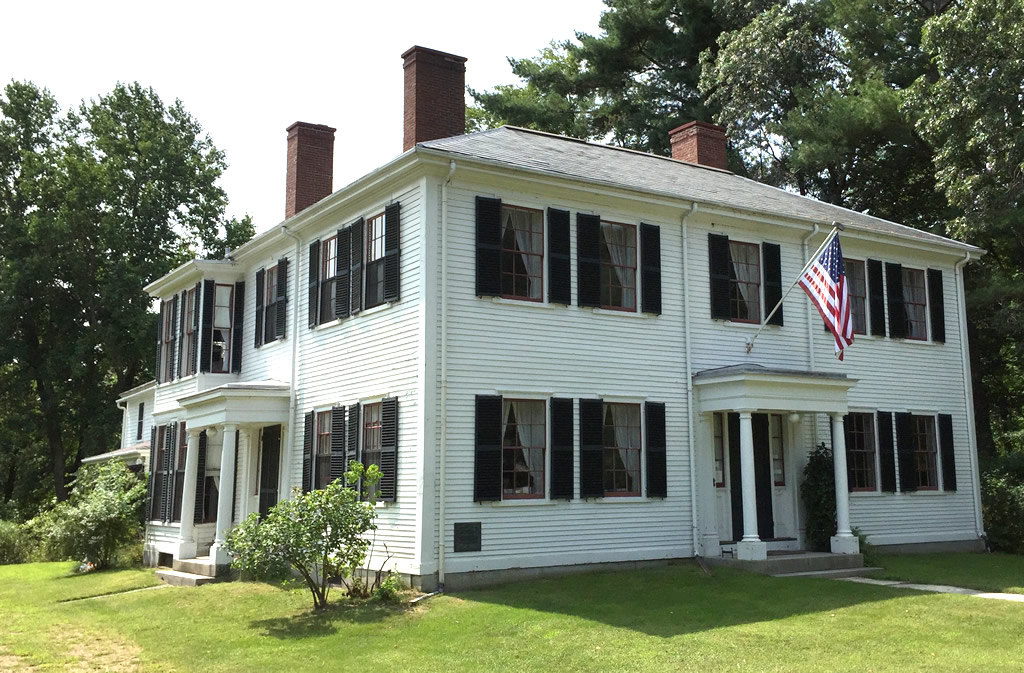
"Bush," the home of Ralph Waldo Emerson in Concord MA.
Built in 1829 as a summer house by the Coolidge family, the house was bought by Emerson as a family residence in July 1835.
The house was a center for meetings of Emerson and his friends, and still contains original furniture and Emerson's memorabilia.
It was here that Emerson wrote his famous essays The American Scholar and Self Reliance, here that he entertained Bronson and Louisa May Alcott, his aunt Mary Moody Emerson, Margaret Fuller, Henry David Thoreau, and many others.
The Great Fire
On July 24, 1872, the house caught fire and was heavily damaged. Luckily there was no serious injury, all of the Emersons escaped, and Emerson's papers were not lost.
Without consulting Emerson, his neighbors took up a collection to pay for repairs. This allowed Emerson to journey to Europe and to Egypt—as he had always dreamed of doing—while repairs were being made. In 1873 the Emersons returned to live in the house, surprised by a town-wide celebration of the event.
Death of Emerson
Ralph Waldo Emerson died here in 1882. In 1890, his wife Lidian Emerson died here, and was buried next to her husband on Authors Ridge in Concord's Sleepy Hollow Cemetery.
The Emersons' daughter Ellen Tucker Emerson, who did not marry, continued to live in the house until her death in 1909. Other friends and relatives lived here until 1948.
Emerson House Museum
"Bush" is still owned by the Emerson family, which has opened it to visitors as a private museum.
Today the house is much the same as when the Emerson family lived in it, although Ralph Waldo Emerson's library is now in Harvard University's Houghton Library, and the furnishings of Emerson's study are on display across the street in the Concord Museum.
The Emerson house is open for visits from late April through late October, Thursday through Saturday from 10 am to 4:30 pm, Sunday 1 to 4:30 pm. Seniors (62+) and students (7 to 17) are favored with discounted admission charges; kids under 7 get in free. The house is closed Monday, Tuesday and Wednesday, and all winter.
Emerson-Thoreau Amble
Beside the Concord Gun House and behind the Emerson house, at 28 Cambridge Turnpike (map), is a footpath called the Emerson-Thoreau Amble, a re-creation of the route Ralph Waldo Emerson, Henry David Thoreau, Louisa May Alcott and other Concordians may have followed on walks between Concord MA and Walden Pond.
Inaugurated in June 2013, the 1.7-mile (2.74-km) walk from Emerson's house to the site of Thoreau's cottage takes 40 to 60 minutes. Here's the trail guide. The unpaved path is uneven in places, may be somewhat muddy after rain (though wood chips and boardwalks reduce this), and requires climbing some short but steepish hills. Sturdy footwear is recommended.
The path may be difficult for those with mobility challenges who may wish to follow paved Walden Street to Walden Pond instead.
Ambling Along...
You can start your walk on the footpath behind Emerson's house, or from Heywood Meadow by the Concord Independent Battery's gun house (a brick garage-like building).
The path wanders down to the Mill Brook, which it crosses on a wooden footbridge, then continues to the edge of a large cultivated field. You turn right and walk around the field to an unpaved road that goes by the Concord Ice Company. At the end of this straightaway, the path turns left and enters the Hapgood Wright Town Forest, crossing wooden footbridges when necessary.
The Amble wanders through the forest, skirting the edge of Fairyland Pond and following the rill fed by Brister's Spring, the source of water used by Brister Freeman, a formerly enslaved Concordian who lived on the hill above in the mid-19th century.
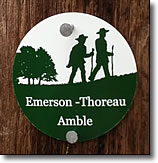 |
|
| Trail marker |
Climb the hill past Brister's Spring and turn right to reach Walden Street and its intersection with MA Route 2. There is a pedestrian crossing and a walk signal to cross this busy four-lane highway.
At Walden Pond
On the south side of the highway, turn left and follow Walden Street (MA Route 126) for a few yards and look for a path into the forest. A few yards into the woods is a signboard and map.
A network of paths and rough tracks meander through the forest here. Favor left-hand and downhill paths to reach Walden Pond at Thoreau's Cove, and the site of Thoreau's house, marked by signs.
A replica of Thoreau's house stands by the Walden Pond parking lot and Visitor Center—worth the walk.
Other paths lead around Walden Pond both along the shore and on the glacial esker ridges above. One path goes up to Emerson's Ridge to a point known as The Lookout which may have presented rewarding long-distance views in Emerson's time, when the landscape was more heavily cultivated and the forests smaller, but now the forests have grown, obscuring the views.
Walden Pond
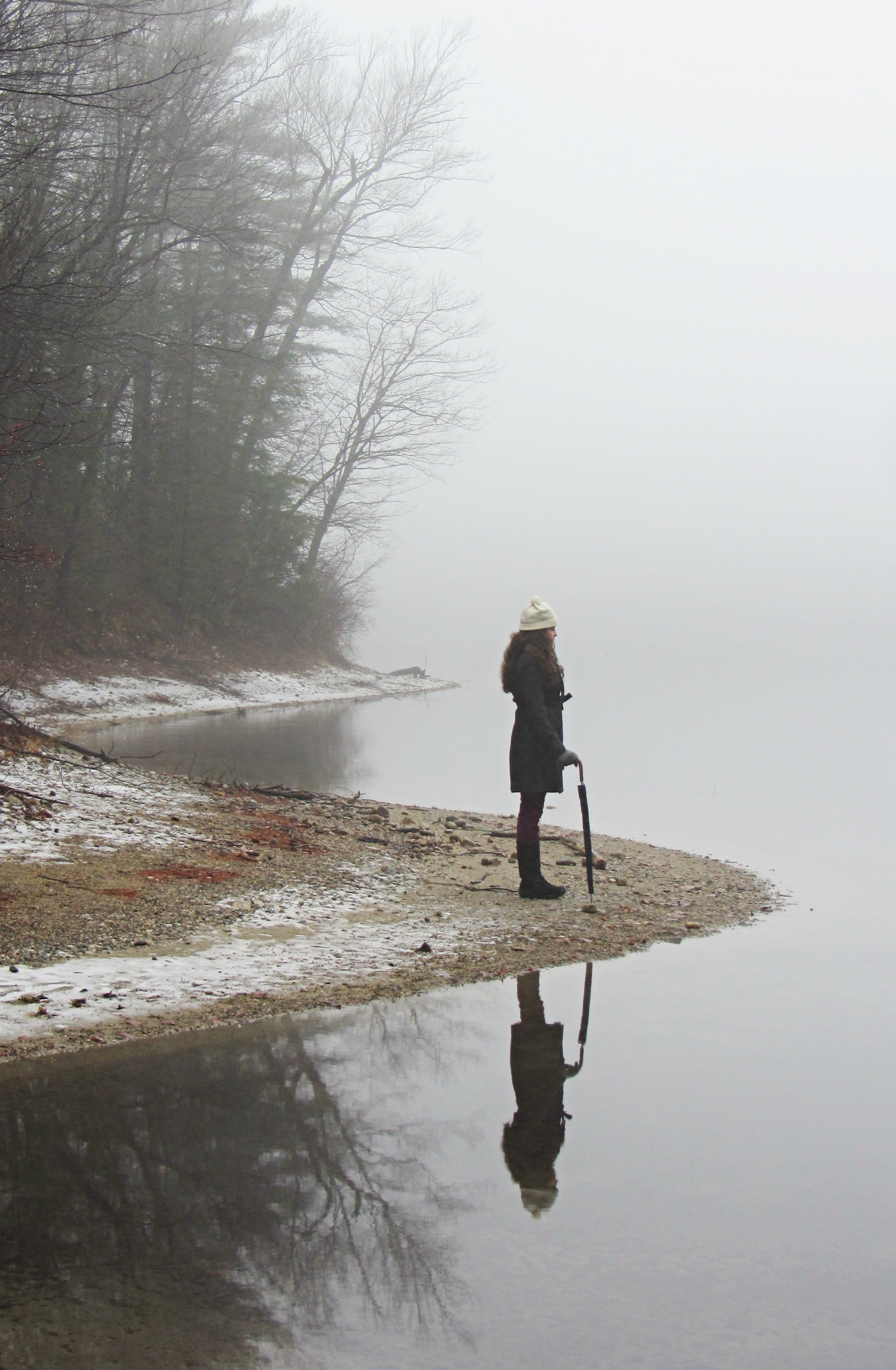
A contemplative moment at Walden in winter....
Henry David Thoreau's writings and residence here made famous this beautiful glacial pond with an unusual geology and ecology 2.2 miles (3.5 km) from Monument Square.
Walden Pond is a 400-acre (162-hectare) state reservation offering hiking trails, swimming, fishing and historical sights (map). Fires, alcoholic beverages, and dogs are prohibited at all times.
Getting to Walden Pond
Walden Pond State Reservation, open all year, is at 915 Walden Street (MA Route 126; map), a 30- to 35-minute walk south of Monument Square.
The beach and circumambulation path are free, so if you walk or bicycle from Monument Square in Concord to Walden as Thoreau did (1.8 miles/2.9 km, 35 to 40 minutes' walk, each way), you can enjoy the pond at no cost.
If you come to Concord by train from Boston, you will actually pass right by Walden Pond: look for it on the right side of the train a short time after leaving the MBTA Commuter Rail station in Lincoln.
You can walk southeast along Walden Street from the Concord Center station to Walden Pond (1.6 miles, 2.6 km, 30 to 35 minutes) or, more historically accurate, you can follow the Emerson - Thoreau Amble, a re-creation of the footpath Emerson and Thoreau may have followed on their strolls to the pond.
If you're driving or bicycling, from Monument Square in Concord Center, follow Main Street south and turn left onto Walden Street at the first intersection (map). Follow Walden Street (Route 126) for two miles (3 km), cross a major highway (MA Route 2), and look for the Walden Pond State Reservation parking lot entrance on the left a short distance farther along. The pond is on your right, on the opposite side of the road from the parking lot.
Access to the Park
Hours of operation change with the seasons, but it generally opens at or soon after dawn, and closes around sunset.
The state reservation's parking lots—the only legal parking available within a mile of the pond—costs $8 per carload for vehicles with Massachusetts registration, $30 for cars registered in other states, in summer.
Parking, stopping and/or dropping off persons at any other location near the park is prohibited. Pay for your official parking at a machine in the parking lot, or by using the Yodel app or website.
Walden Fills Up Early in Summer!
On any hot day in summer—especially weekends and holidays—the park and pond will reach full capacity and be closed by mid-morning at the latest. (On July 23, 2022, a very hot day, the pond closed at 8:22 am.) You may have to wait until mid-afternoon for it to re-open—or it may not reopen at all. The Massachusetts Department of Conservation and Recreation (DCR) website has a page listing all closures and estimated reopening times. More...
When the lots are full, the pond has reached its full visitor capacity, the parking lots are closed, cars are turned away, and no drop-off or walk-in visitors are allowed.
This is to guard against pollution of the pond by the throng of visitors. (As it is, the chemistry of the pond's water is already being changed by the presence of so many bodies in it.)
Visitor Center
The Visitor Center is a Net Zero, LEED-Certified ecological building with its own solar carport for electricity generation, electric vehicle charging stations, even solar-powered parking pass machines.
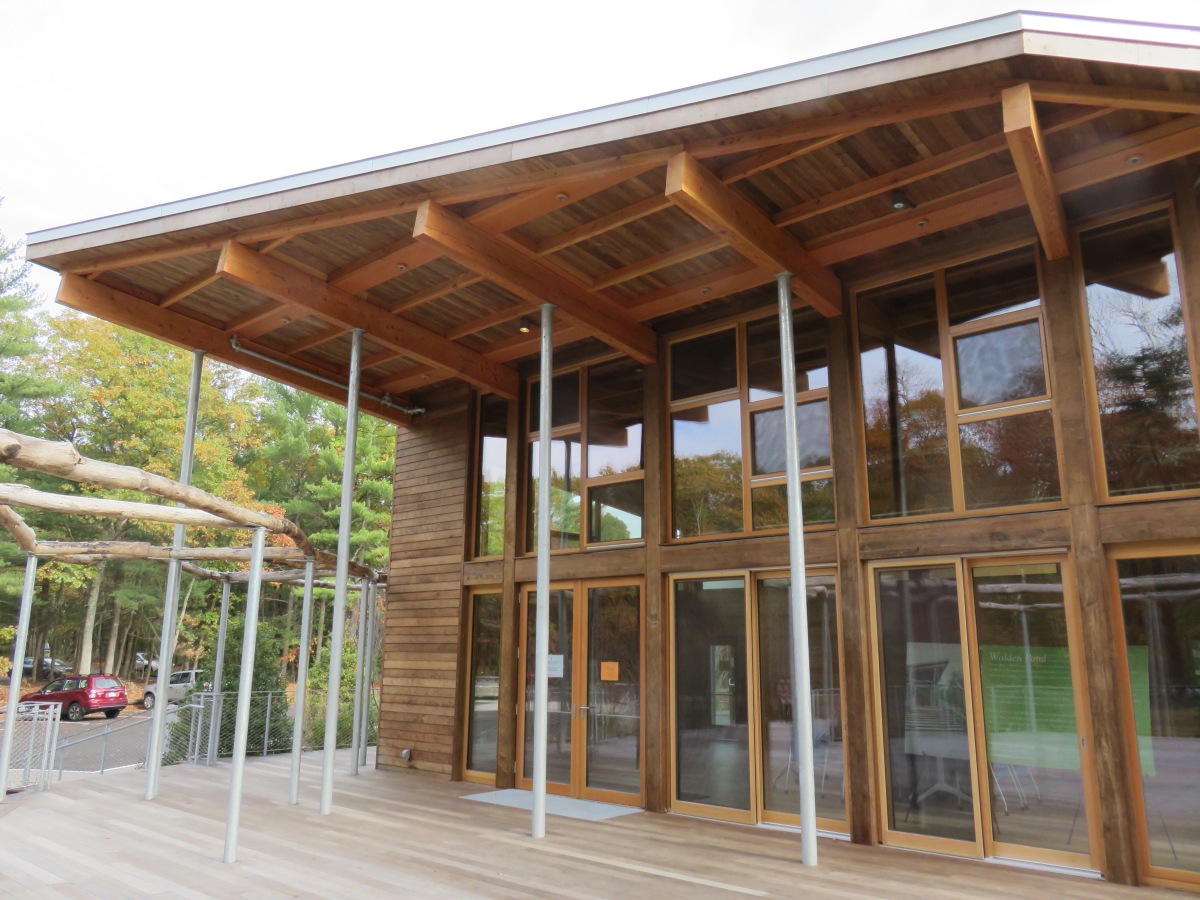
The ecological Walden Pond Visitor Center.
Swimming
In summer, visitors from Boston and beyond come to swim in its cool water and take the sun on its few narrow sand public beaches. There's a boat ramp for launching your boat, canoe or kayak. Internal combustion motors are not allowed, only quiet electric motors.
Fires, alcoholic beverages and dogs are prohibited in Walden Pond State Reservation at all times.
Self-Guided Walking Tours
Click here for official Walden Pond State Reservation Self-Guided Walks.
The Walden Pond and Woods Guide App by the Walden Woods Project offers an audio/video guide to Walden Pond tours. It's available as a smartphone app, or click here for the Web version. (Cellphone signals at Walden Pond are not always strong or reliable.)
Walk Around the Pond
It's one of the most famous and popular state parks in Massachusetts. At all times of year people come to follow the 1.5-mile (2.4-km) trail around the pond and to visit the site of Thoreau's little house. The walk all the way around the pond takes about one hour at a comfortable pace, less if you walk briskly and don't linger at the site of Thoreau's house too long. Remember: fires, alcoholic beverages and dogs are prohibited!
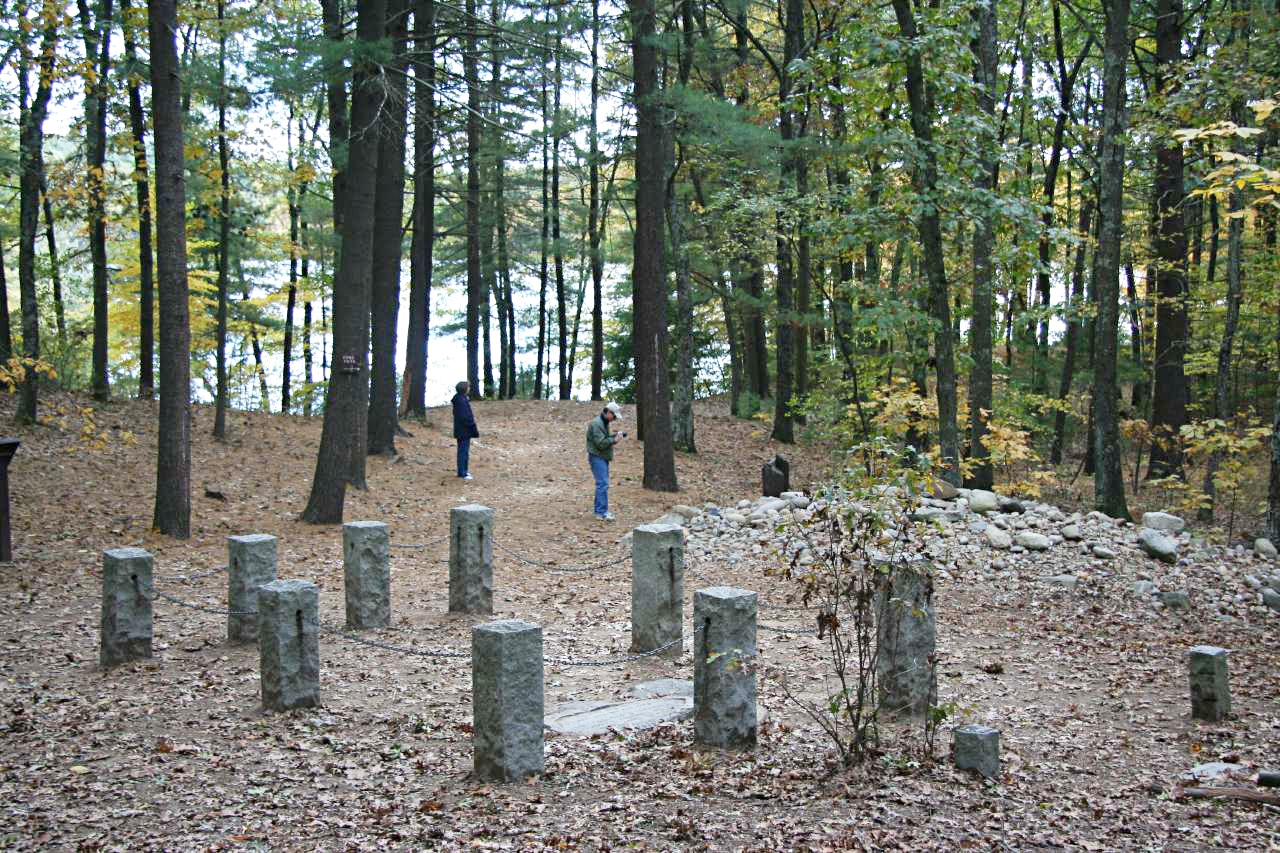
Site of Thoreau's little house at Walden Pond, Concord MA.
Henry David Thoreau
Thoreau, a school teacher, surveyor, pencil-maker, writer, folk philosopher and social critic, moved from Concord to Walden in 1845 and lived here in a simple one-room cabin for two years, two months and two days. During his stay he basically founded the study known as ecology.
His observations of plants, animals, the passing seasons and his naturalist philosophy were published as Walden, or Life in the Woods, in 1854. Over the years, his life and work have come to exemplify living in harmony with nature.
Thoreau's philosophy derived from the Transcendentalism of his friend and mentor Ralph Waldo Emerson, who in fact provided the land (part of his firewood lot at Walden) for Thoreau's little house. In essence, Thoreau lived a life that Emerson, because of his eminence and family ties, could not.
The replica of Thoreau's house is next to the parking lot, near the pedestrian crossing to the pond. The actual site of Thoreau's original house is a 15-minute walk around the pond, marked by granite posts (map). In previous years it was marked by a cairn built up by Thoreau pilgrims who left stones in commemoration of their visits.
Walden's Unique Geology
Walden Pond is a kettle pond formed when a huge iceberg-like chunk of glacial ice, buried in the glacial moraine, melted.
Walden is deep: over 100 feet (30.5 meters) in the middle. The bottom of Walden still has the shape of the chunk of ice that melted here thousands of years ago.
Because waters filter into it from surrounding sandy soils, the pond is essentially oligotrophic, that is, it has few organic nutrients, so few plants grow in it, keeping the water pure and clear. However, nitella algae, over 10,000 pounds of it, grows naturally in Walden's depths, as does lake quillwort, a plant that grows nowhere else in Massachusetts, and these growths help to give the pond its special character.
But the "nutrients" added to the pond annually by thousands of swimmers, not to mention those contributed by visiting ducks and geese (fed by humans), and seepage from the park's toilets, may turn the pond eutrophic, contribute to the growth of algae and water plants, and upset its unique ecology.
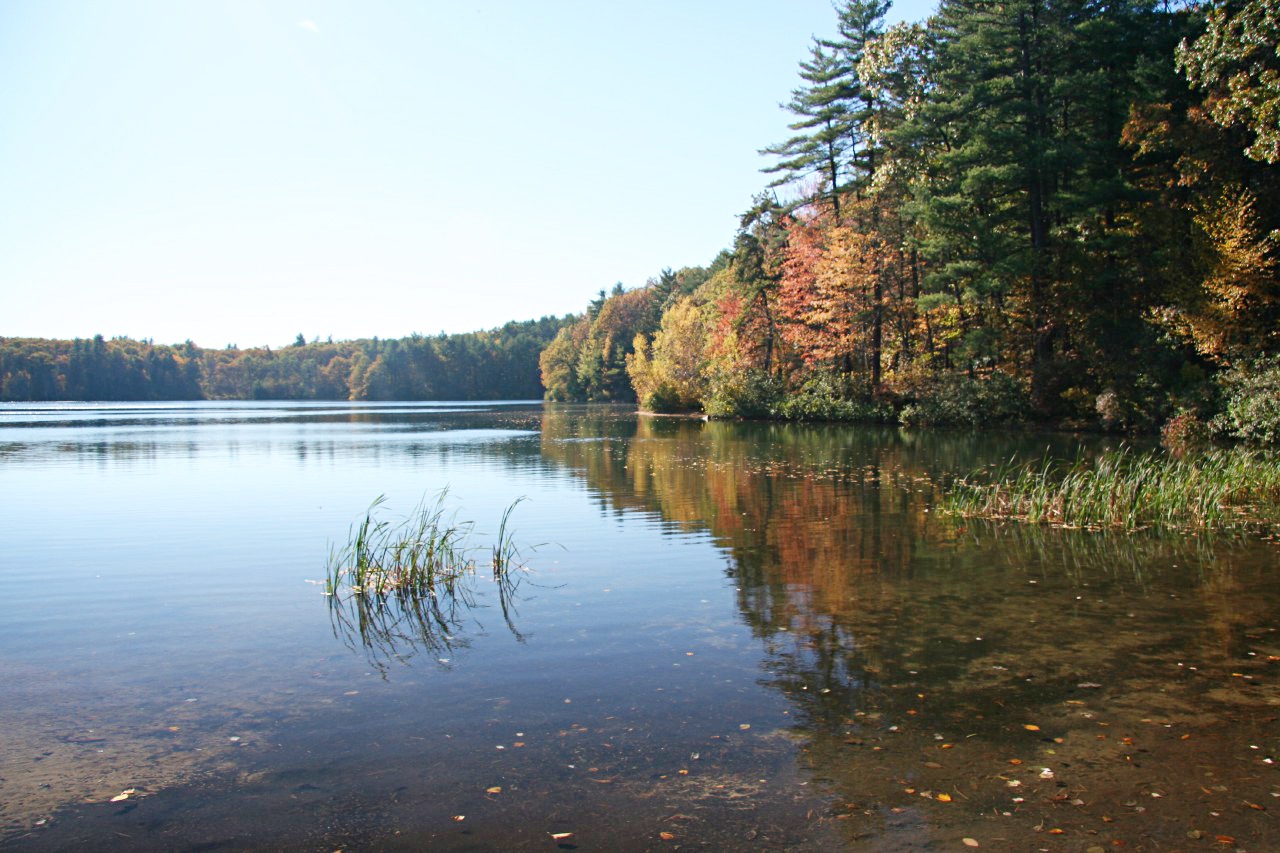
The problem is, quite simply, that Walden is beautiful and historic, and a lot of people want to enjoy its magic. Official efforts to control the number of visitors and their impact on the pond have been going on for over a century, with some success.
Concord River
Two small rivers, the Sudbury and the Assabet, flow together in Concord MA at Egg Rock (Nashawtuck) to form the Concord River (map) which then flows north and into the Merrimack River at Lowell.
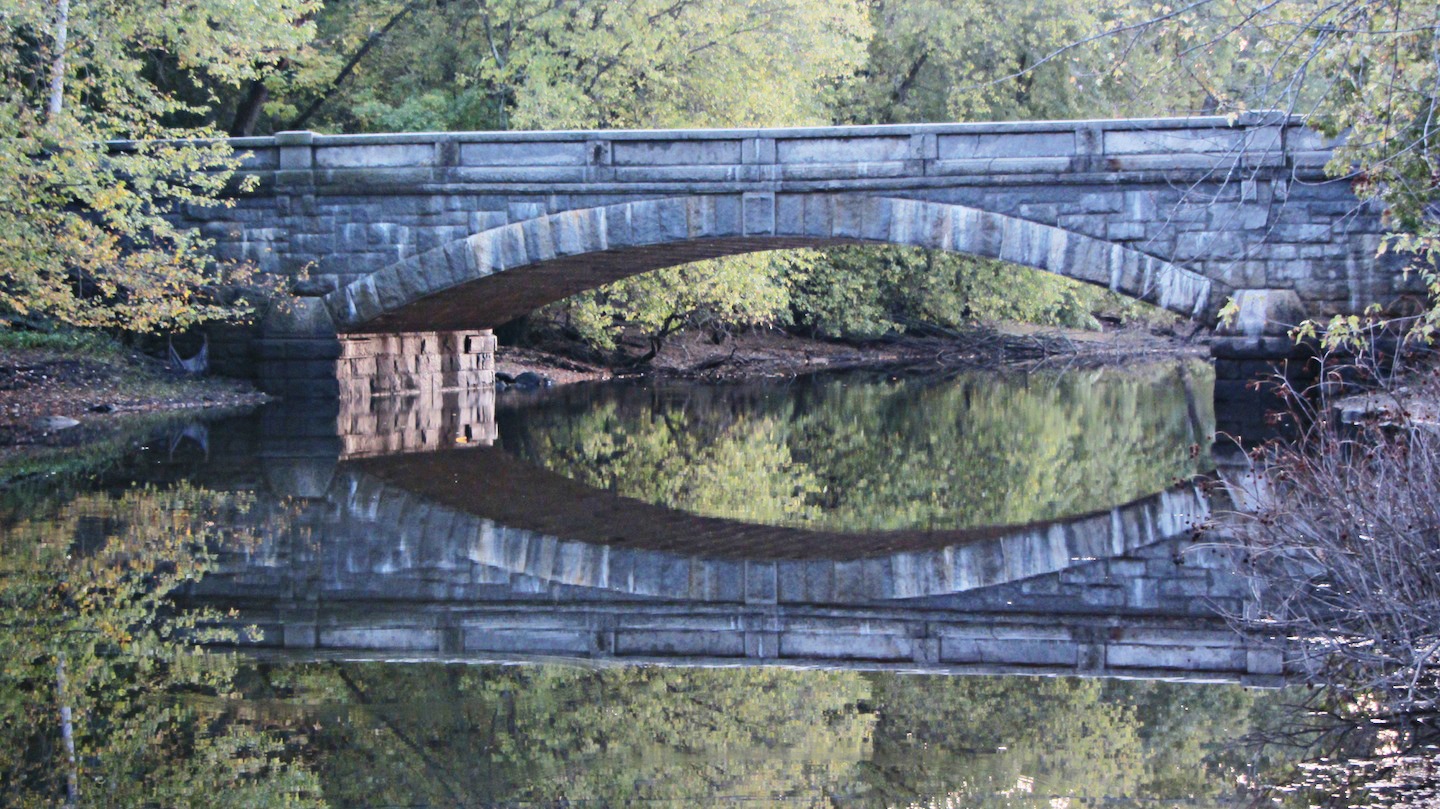
Nashawtuc Road Bridge over the Sudbury River...
In Concord, grand houses, gardens and the campus of Concord Academy grace the riverbanks, alternating with expanses of meadow and forest to make a serene and lovely landscape, the one so enjoyed—and described—by Henry David Thoreau and Ralph Waldo Emerson.
There are no swimming or camping places along the river.
A Bit of History
In 1635 a small group of English settlers came to Musketaquid, the "river plains of grassy (muskeht) meadows," and to the Nashoba Massachusett tribe's village on Nashawtuck Hill where two rivers flowed and became one.

Nashawtuck Hill (Egg Rock) & the river confluence in winter...
Musketaquid was headed by Tahattawan as deputy for Squaw Sachem, paramount chief of the Pawtucket federation, the female leader of most native peoples near Massachusetts Bay. Her domain, once peopled by thousands, had been decimated by epidemics of European diseases in 1618.
On August 5, 1637 she, Tahattawan and other native leaders signed a deed with the English settlers granting them rights in six square miles of land destined to be the Town of Concord.
Rent a Canoe or Kayak
South Bridge Boat House, 496 Main Street in Concord, rents canoes and kayaks small and large, with paddles and flotation vests, from Memorial Day (end of May) until the first snow (usually in October).
You can rent by the hour or the day, with reduced prices on weekdays. Weekends are the busiest times on the river, of course, but it's plenty big enough for everyone.
Bring Your Own
If you have your own canoe, kayak, or stand up paddle board, you can put it in the water from a landing just downstream from Egg Rock near the river bridge on Lowell Road, about a half mile (800 meters) west of Monument Square (map). You'll recognize the bridge by all the cars parked along the road by paddlers who have already launched their vessels.
Where to Paddle
Downsteam
Starting from the South Bridge Boat House on the Sudbury River, you can paddle downstream, under two road bridges, past Egg Rock (Nashawtuck) where the Sudbury joins the Assabet River to form the Concord River. Look for the inscruption on the rock at water's edge:
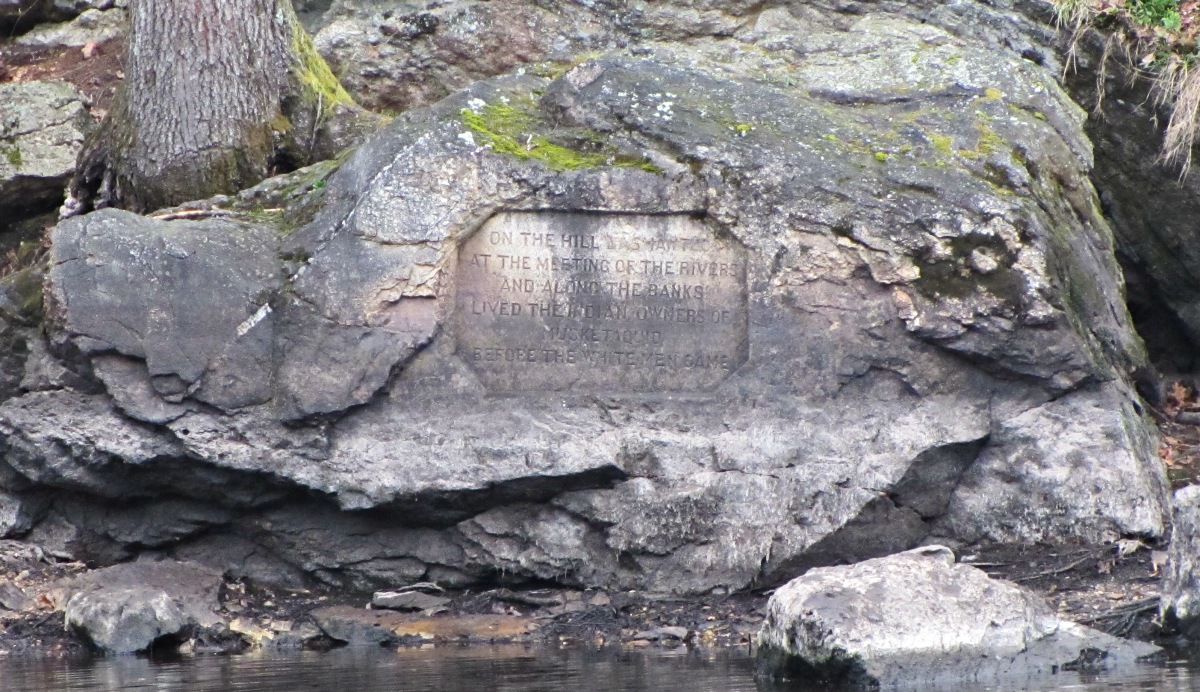
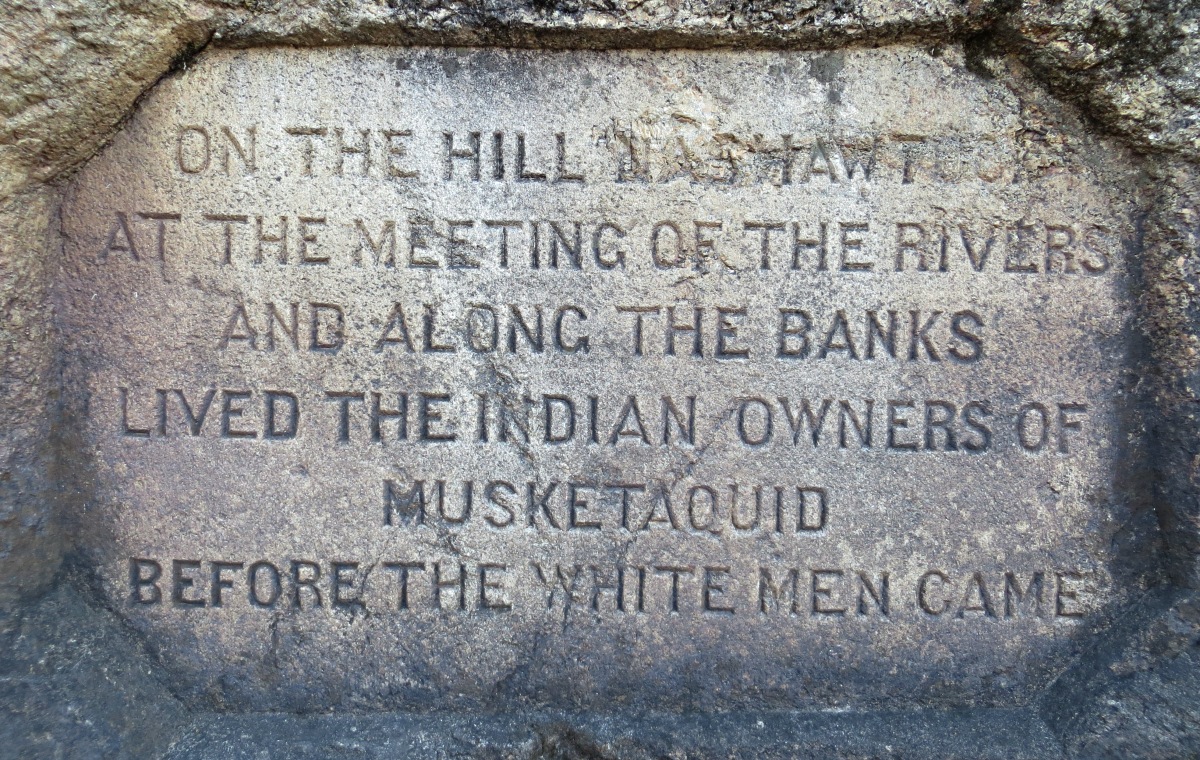
Continue downstream, beneath the Lowell Road bridge, to reach the Old North Bridge in Minute Man National Historical Park. The voyage, including paddling back upstream to the boat house, may take 2 to 2-1/2 hours, depending on how fast you paddle.
Beyond the Old North Bridge, the river continues past the Buttrick Mansion (North Bridge Visitor Center), turns east and follows the northern border of the Great Meadows National Wildlife Refuge before turning north toward Lowell.
Upstream
Paddle upstream (south) on the Sudbury River from South Bridge Boat House, beneath the Commuter Rail railroad bridge and you'll cruise along mostly unpopulated river banks, beneath the MA Route 2 and Sudbury Road bridges, eventually to Fairhaven Bay, a widening of the water popular as a vista among Concord's 19th-century litterati. The river continues for miles to the south, to reservoirs in Framingham.
Walking the Trails
The Town of Concord MA Division of Natural Resources publishes a River Confluence Trail Guide (PDF) which, along with this Google Map, can help you find your way on foot to Nashawtuck (Egg Rock).
A Picnic Spot
On the southeast side of the confluence opposite Egg Rock, accessed via the Lowell Road boat launch ramp, is a small grassy area good for a picnic. (Here are all the best picnic spots in Concord.) No facilities except a bench. Be sure to pack out your trash and leave ithe place in good condition.
More Information
OARS, the organization for the Assabet, Concord and Sudbury rivers, offers online trail maps, brochures and other information on recreational possibilities along the rivers. More...
There's additional information on the website of the Sudbury Valley Trustees. More...
West Concord
Formerly Concord Junction, this village 2.7 miles (4.35 km) west of Concord center has a surprising number of fine food shops and eateries, as well as Concord's other train station.
Patriots Day
The most time of the year in Concord is Patriots Day, April 19th, when the battle at the North Bridge is re-enacted and commemorated with parades, costumes, musket and cannon volleys, cheers and speeches.
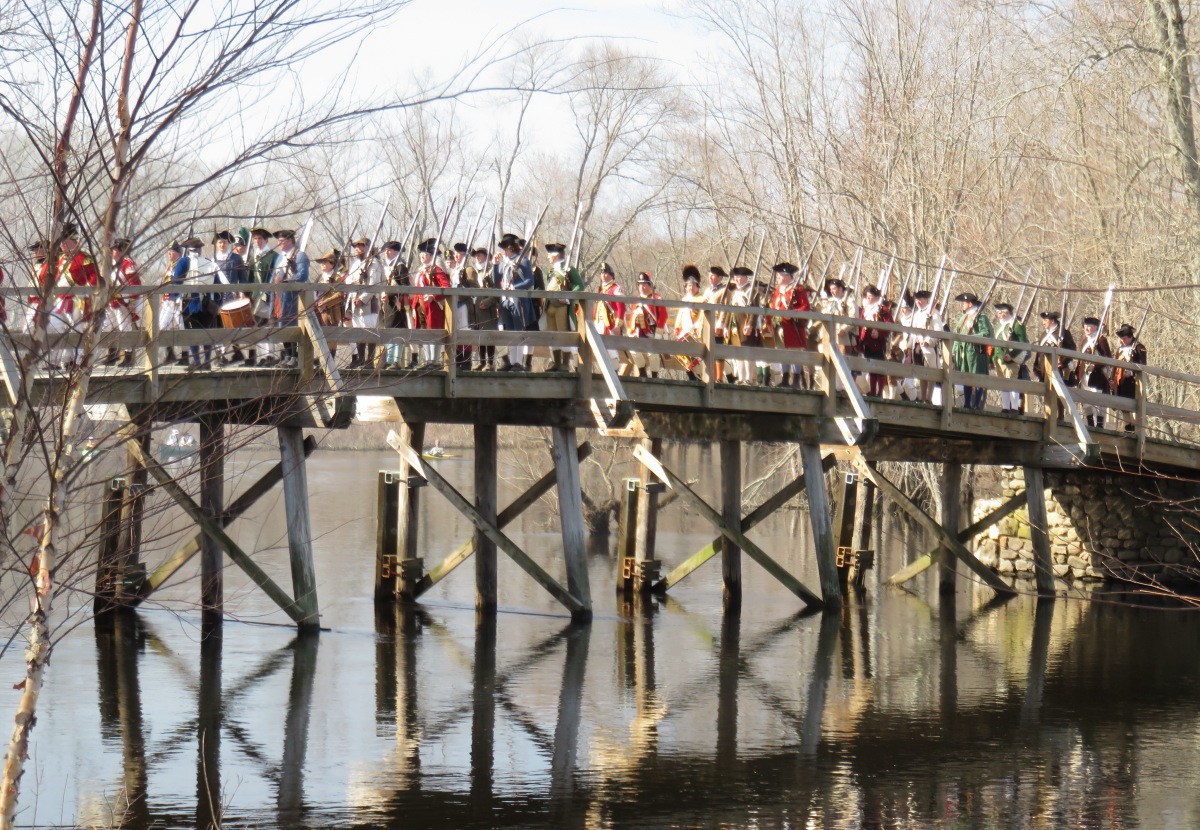
Minutemen marching across Old North Bridge on Patriots Day.
Where to Stay
Its fine inns, B&Bs and hotels allow you to stay the night comfortably if you wish. With more than two dozen restaurants, it can satisfy your appetite, from a simple cup of coffee or a picnic to a gourmet repast.
Use this handy Hotel Map with Prices to find the lodgings you want in Concord.
Concord's Colonial Inn
Right on Monument Square in the center of Concord, it's a fine place for a snack, a meal, a drink, or a night's stay. Twelve of the 60 rooms are in the historic old part of the inn, the rest in a modern hotel-style annex.
Hawthorne Inn
Across Lexington Road from The Wayside and a short walk from Orchard House, it's perfect for Louisa May Alcott pilgrims.
Longfellow's Wayside Inn
In neighboring Sudbury, this colonial-era inn immortalized by Henry Wadsworth Longfellow in his Tales from a Wayside Inn, is still in operation, offering food, drink and lodging. On the grounds are a restored Grist Mill and the Martha-Mary Chapel, a typical New England meetinghouse (church building).
Element Lexington Hotel
A 3-star hotel in nearby Lexington just off I-95 but within walking distance of Battle Road, the very modern 123-room Element has all the latest technologies and comforts, including in-room coffee-makers, microwaves and mini-fridges; an indoor swimming pool and high-tech exercise room; a congenial bar/lounge, buffet breakfast, and a 24-hour snack shop. More...
Hotels in Nearby Towns
Hotels in Bedford MA, 5 miles (8 km) northeast of Concord, are easily accessible along Bedford Road (MA Route 62; map).
Hotels in the cities of Burlington and Waltham are farther away, sometimes through heavy and/or confusing traffic (I-95/MA Route 128), though your GPS may solve that problem.
Keep in mind that MBTA Commuter Rail trains connect Boston (North Station), Cambridge (Porter Square Station) and Concord numerous times daily. You don't need a car to visit Concord: you can take the train out from Boston on a day-trip.
You can get to Concord MA by car, bike or train for a day of walking, biking, swimming or shopping.
Transportation
Concord is 20 miles (32 km) NW of Boston, 15 miles (24 km) NW of Cambridge, 6 miles (8 km) W of Lexington by car, train, bike, rideshare or taxi.
Car
Concord is 20 miles (32 km) northwest of Boston along MA Route 2 (map). From Interstate 95 take the exit for Route 2 West to Concord. At the intersection with MA Route 126/Walden Street, turn left (south) for Walden Pond or right (north) for Concord Center.
A slower but more interesting route is via Battle Road from Lexington: from Route 2, take Exit 57 and follow MA Route 4 north to Lexington Center and Lexington Green, site of the first battle of the Revolutionary War. Bear left at the Minuteman statue (southeast point of the Green) and follow Massachusetts Avenue to MA Route 2A. Turn right on 2A and follow the signs reading Battle Road.
This is the route taken by the British troops going out to Concord on April 19th, 1775, to search for arms stockpiled illegally by the colonials.
The road follows a route parallel to Battle Road Trail (a foot- and bike-path), past the entrance to the Minute Man National Historical Park Battle Road Visitor Center and the place where Paul Revere was captured by British soldiers after his historic ride to alert the countryside to the British expedition. Eventually, bear right along Lexington Road to reach Concord center and Monument Square.
Parking in Concord
Parking on streets is free. Parking lots, also free, are the Concord Town Lot on Keyes Road off Main Street behind the Concord Visitor Center, and behind 14 Walden Street (enter between 12 and 14 Walden Street) near the US Post Office.
Train
On weekdays, 20 MBTA Commuter Rail trains a day leave Boston's North Station on the Fitchburg Line for the 40-minute trip to Concord. On Saturday there are normally 12 trains, and on Sunday, 8. More...
The train can also be boarded at the MBTA Red Line's Porter Square subway station in Cambridge (go north on Massachusetts Avenue from Harvard Square for about a mile, and the station is next to the shopping center, under the iron bridge).
Bicycles are allowed on noin-rush hour trains, so you can take the train one way and ride along the Minuteman Bikeway the other way (see below).
The train passes right along the shore of Walden Pond three minutes after departing Lincoln Station—look out the right side of the train. It arrives two minutes later at Concord's Depot on Thoreau Street at Sudbury Road (map), which is a 10- or 15-minute walk (0.6 mile, 1 km) from the Concord Visitor Center and Monument Square.
Bus
The only bus transportation is a weekday commuter service operated by A Yankee Line, Inc. The bus departs Acton and Concord around 7:00 am and arrives in Boston at Copley Square around 7:50 am. Return buses depart Copley Square at 2:45 pm, arriving in Concord at 3:30 pm; and 5:05 pm, arriving in Concord at 6:00 pm. No weekend service. Obviously, this service is convenient for commuters, but not for day-trips from Boston to Concord. More...
Bicycle
The Minuteman Commuter Bikeway extends from Boston and Cambridge to Lexington, Bedford and Concord. More...
Boston - Concord by Bike & Train
MBTA Commuter Rail trains on the Fitchburg line depart Boston's North Station and Cambridge's Porter Square station and travel to Concord and beyond. Bicycles are permitted on non-rush hour trains, (the rules are here) so you can take your bike to Concord and back; or go one way on the train and ride along the Minuteman Commuter Bikeway the other way, stopping in Lexington to see the sights (map).
Getting Around in Concord
The Concord Trolley is a free hop on-hop off bus connecting the MBTA Commuter Rail Concord Center station on Thoreau Street with the principal visitor destinations in town—if it receives funding and is in operation; this changes from year to year. When it's running, stops include Concord Visitor Center, Old North Bridge, Concord Museum & Emerson House, Orchard House & The Wayside, Meriam's Corner (Battle Road Trail) and Minute Man National Historical Park Visitor Center. Twice a day it also stops at the MBTA West Concord station. More...
Note that the trolley does not take you to Walden Pond, a 1.6-mile (2.6-km, 30- to 35-minute) walk southeast along Walden Street from the station.
